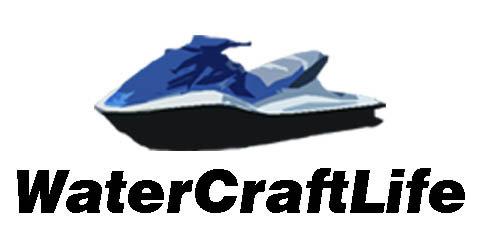

What Does Yacht Certified Mean and Why You Would Want It
If you are unfamiliar with yacht certification, you are encouraged to learn more about what it means and why it is so important for both current and prospective boat owners.
The term “Yacht Certified” refers to a quality control process governed by the NMMA, an organization that ensures that yachts and boats are constructed to industry standards. As many as 90% of boats currently on the water in the U.S. carry an NMMA certification placard.
The NMMA certification process serves to remove these headaches by requiring participating manufacturers to pass physical inspections.
What Does Yacht Certified Mean?
Yacht certification is handled by the National Marine Manufacturers Association (NMMA). The program is designed for manufacturers, so that they may show prospective boat buyers that the vessel has been built to meet or exceed the standards of the American Boats & Yacht Council (ABYC).
Every model of a manufacturer’s fleet must be inspected annually for Yacht Certification. If a company decides to participate in the NMMA program, they run every design plan by the organization and continue to produce vessels that meet these same standards.
What Are the Standards?
Standards are applied to the critical components of the yacht so that consumers know that they are purchasing a boat that has passed an extensive physical inspection. The following components are emphasized during the inspection process:
- Bilge pumps
- Bilge blowers
- Fuel hoses and tanks
- Steering parts
How Do Boats Qualify to Be Yacht Certified?
To meet the definition of a yacht, the boat must be 26 feet or longer. The NMMA does build capacity tags for boats shorter than 26 feet, so the certification process indeed covers a wide range of vessels.
Manufacturers apply for certification on their behalf and pay annual membership fees. They must also meet inspection filing deadlines once they have become NMMA members. As such, membership in the Yacht Certification program shows that a company is determined to meet or exceed industry standards.
How Do You Know A Boat Is NMMA Certified?
You will know a boat is Yacht Certified if you see a sticker showing “NMMA Certified using ABYC standards.” This will be located overtop either the capacity or yacht plate at the helm of the boat. You can ask your dealer if you don’t happen to notice the placard. If you go to a boat show, you may notice a directory that explicitly shows which boats among the lineup are NMMA certified.
Why You Would Want Yacht Certification
Prospective buyers can take advantage of the NMMA certification program as a way to ensure consistent quality across the board, regardless of manufacturer. For new owners, it is challenging to shop for boats. Prospective buyers don’t usually get to take a boat for a test drive, as they would with a vehicle.
Approximately 90% of all boats currently on the water in the United States are certified by the NMMA. From a manufacturer’s perspective, it is an excellent way to build trust with consumers.
Safety Standards of a Yacht Certified Boat
Since you won’t generally be able to go for a test drive, it’ll give you peace of mind to know that a vessel is a yacht certified by the NMMA. Research has shown that NMMA-certified boats are seven times less likely to receive safety recalls than non-certified boats.
While it’s true that the U.S Coast Guard inspects every new yacht for safety, the NMMA certification is an expansion of the standard federal inspection checklist. There aren’t any Coast Guard requirements for steering systems, storage batteries, or exhaust systems, among many other components.
Passenger Capacity on a Yacht Certified Boat
Recreational vessels longer than 26 feet in length are excluded from passenger capacity and stability standards. In smaller boats, you’ll notice marked placards somewhere along the interior, which clearly states passenger capacity and the maximum allowable weight.
Equipment Issues Can Be Hard to Diagnose
Just as is the case with cars and trucks, boat issues can be hard to diagnose. When you finally land your dream boat, the last thing you want on your hands is a mechanical issue that’ll land it in the shop for several days, if not weeks.
There are thousands of trained technicians who can determine whether a given component passes the ABYC test. If there are any issues, they can be resolved immediately while the vessel is still at the factory.
One of the many categories inspected to meet ABYC standards is electric wiring. This is significant because marine electrical systems are susceptible to a host of complicated problems, including bad connections, improper inverter installations, and poor choices for conductor materials.
Quality Assurance
The regulations of NMMA Yacht Certification state that participating manufacturers must have at least one staff member who is knowledgeable about ABYC standards. Participating staff must attend training sessions and successfully pass exams testing their level of competency.
As a prospective buyer, you’ll know that any craft that is NMMA Yacht Certified has been constructed under the guidance of a trained industry expert. This provides manufacturers with a convenient process for quality assurance.
Consistency
Every year manufacturers update their fleet to include new technology. There is no way of knowing the actual consequences of such modifications unless the boat is tested and approved by an independent technician.
The NMMA yacht certification program requires manufacturers to ensure that their boats are up to code every model year, even if no significant modifications have been made to the design schematic.
Consumer Satisfaction Index (CSI)
The Yacht Certification program provides makers with an established structure for tracking customer feedback. At the very least, companies must send their customers a census-type survey within the first 12 months of ownership. The NMMA then asks that the survey results are tabulated and forwarded up the chain to the manufacturer’s internal management.
Members also have the option to take part in the Marine Industry Customer Satisfaction Awards. This is a great way for prospective buyers to continuously view the top-rated brands and dealerships from this page.
How Long Do Yacht Certifications Last?
Certification inspections take place at the factory where the boats are originally manufactured. The dealerships do not generally take part in any certification process, so it’ll be more challenging to determine whether a used boat is up to code. You may find out that the vessel was originally Yacht Certified, which certainly helps with models that haven’t seen too much wear or tear.
Manufacturers provide owners with certification programs confirming the quality of used boats. Membership in such services involves having the yachts routinely maintained by certified technicians. The incentive for owners to enroll in such programs is that this coverage should help boost the resale value of their yacht.
Are There Any Other NMMA Certifications?
The NMMA has certification categories for many different types of watercraft, including personal watercraft. The organization also helps ensure that boat trailers are manufactured per code. Boat trailer inspections emphasize trailer and tire capacity ratings, brakes, and hand winches, among other critical components, to provide owners with peace of mind while they transport their prized possession.
Final Thoughts
Yacht Certification is a manufacturing quality vetting process hosted by the National Marine Manufacturers Association (NMMA). The standards are established under the guidance of the American Boats & Yacht Council (ABYC).
The advantage of the certification process is that consumers can be assured that the critical components of the boat have been inspected by a trained representative of an independent organization, a true neutral party.

- Captains Queen Yacht
- Lady of Sea
- Black Princess
- 135 Feet Yacht
- Desert Rose
- Java Yacht Rental Dubai
- Lotus Mega Yacht Dubai
- Birthday Parties
- Corporate Charter
- Wedding Charter
- Family Gatherings
- Limo Rental
- Share A Yacht
- Dhow Cruise
- New Years Eve Yacht
- Lotus Mega Yacht Brunch
- Megayacht Dinner Cruise

Unraveling the Mystery of Yacht Certification: What Does it Really Mean?

what does yacht certified mean? Yacht certification is a process that evaluates a yacht’s safety, performance, and overall quality to ensure it meets necessary requirements for safe operation in various waters. Understanding the details of yacht certification is important for all yacht owners to ensure the safety of their vessel and those on board. Therefore, if you are considering a yacht charter Dubai , make sure to select a rental company that also possesses the necessary yacht certification to ensure a safe and enjoyable experience on the water
What does Yacht Certification mean?

Yacht certification involves a comprehensive evaluation of a yacht’s design, construction, safety features, and other factors that determine its seaworthiness. The certification process is conducted by recognized certification bodies that assign a certification level or category to indicate the yacht’s suitability for specific types of water and weather conditions.
Who gave yacht certificate?
The NMMA (National Marine Manufacturers Association) certification process is designed to ensure that yachts and boats are constructed to industry standards. The NMMA works with manufacturers to establish a set of standards that ensure that yachts and boats are safe, reliable, and meet environmental requirements. Yachts that meet these standards are considered to be “NMMA certified.”
Yachts that pass the NMMA certification process are issued a certification placard that indicates that the yacht has met all applicable standards. This placard is typically displayed on the yacht’s dashboard or other visible location. In addition to providing reassurance to yacht owners, the NMMA certification can also be helpful in the event of an insurance claim or other legal issue.
Which physical inspection is important for NMMA certificate?
The NMMA certification process involves a series of physical inspections that are conducted by independent inspectors. The inspections cover a range of topics, including construction materials, fuel systems, electrical systems, and safety equipment. The inspections are designed to ensure that the yacht meets all applicable standards and regulations, and that it is safe and reliable for use on the water.
How do boats qualify for certificate?
In order to be eligible for yacht certification, a boat must have a length of 26 feet or longer, according to industry standards. However, the NMMA also provides capacity tags for boats shorter than 26 feet, meaning that the certification process covers a wide range of vessels.
To become certified, boat manufacturers must apply for certification on their own behalf and pay annual membership fees to the NMMA. Once they become members, they are required to meet inspection filing deadlines as part of the certification process. By becoming a member of the Yacht Certification program, manufacturers demonstrate their commitment to meeting or exceeding industry standards for safety, reliability, and environmental impact.
How to get information about a boat certification?
A boat that has been NMMA certified will have a sticker that reads “NMMA Certified using ABYC standards” located either over the capacity or yacht plate at the helm of the boat. If you are unsure whether a boat is certified or not, you can always ask your dealer. Alternatively, if you attend a boat show, you may find a directory that explicitly lists which boats in the lineup are NMMA certified.
Is there any other NMMA certificate?
Yes, the NMMA has certification categories for various types of watercrafts, including personal watercraft, pontoons, and fishing boats, among others. The NMMA’s Certified Trailer program ensures that boat trailers are also manufactured per code. These inspections emphasize trailer and tire capacity ratings, brakes, and hand winches, among other critical components, to provide owners with peace of mind while they transport their prized possessions.
Why is Yacht Certification Important?

In addition to ensuring the safety and seaworthiness of a yacht, certification is important for several other reasons:
Requirement for yacht owner to operate vessel
First, certification is often a requirement for yacht owners who want to operate their vessel in certain waters. Many countries have regulations that require yachts to be certified before they can be operated within their waters, and failure to comply with these regulations can result in penalties and fines.
Insurance purpose
Second, certification is important for insurance purposes. Many insurance companies require yachts to have a certain level of certification before they will provide coverage. This is because certification indicates that a yacht has met certain safety and performance standards, reducing the risk of accidents or damage. Without certification, yacht owners may have difficulty obtaining insurance coverage or may face higher premiums.
Helps in resale value
Third, certification can be important for resale value. A yacht that has been certified to meet certain standards may be more attractive to potential buyers, as it indicates that the yacht has been well-maintained and is safe and seaworthy. This can be especially important for owners who plan to sell their yacht in the future.
Important for environmental sustainability
Finally, yacht certification is important for environmental sustainability. Some certification schemes evaluate a yacht’s emissions, noise levels, and other factors that can affect the marine environment. By meeting these standards, yacht owners can reduce the environmental impact of their vessel and contribute to a more sustainable yachting industry.
Yacht Certification Standards
Yacht certification standards are a set of guidelines that provide a framework for evaluating the safety and performance of yachts. Various yacht certification schemes exist globally, including the European Union’s Recreational Craft Directive (RCD), the American Boat and Yacht Council (ABYC) standards, and the International Organization for Standardization (ISO) standards.
Benefit of yacht certification levels
Yacht certification levels and categories are used to classify yachts based on their intended use and the conditions for which they are suitable. These categories and levels can vary depending on the certification scheme and the country in which the yacht is registered.
Each certification scheme may use different standards or criteria to assess yachts. Some schemes may focus on safety and performance, while others may emphasize environmental impact or other factors. Yacht owners should carefully research the certification schemes that apply to their yacht and ensure that they meet all applicable standards and criteria. This can help to ensure that the yacht is operated safely, legally, and in compliance with all relevant standards and regulations.
In general, yachts that are certified to higher levels or categories are designed to withstand more extreme conditions and are generally considered to be safer and more seaworthy. Yacht owners should ensure that their vessel meets the necessary certification standards for its intended use and operating conditions.
List of some Common certification levels

Before discussing the levels, let’s have a look at some important things to consider for each yacht. In the NMMA certification process, a yacht is inspected to ensure that it meets industry standards for safety, reliability, and environmental impact. This includes a detailed inspection of critical components of the yacht, such as bilge pumps, bilge blowers, fuel hoses and tanks, horns, lights, and steering parts.
Bilge pumps are an essential safety feature of any yacht, as they help to remove water from the bilge area. During the NMMA inspection process, bilge pumps are checked to ensure that they are functioning properly and that they are of the appropriate size and capacity for the yacht.
Bilge blowers are another important safety feature that helps to prevent the buildup of dangerous gases in the bilge area. During the NMMA inspection process, bilge blowers are checked to ensure that they are functioning properly and that they meet industry standards for safety.
Fuel hoses and tanks are critical components of the yacht’s fuel system, and they must be constructed to meet industry standards for safety and reliability. During the NMMA inspection process, fuel hoses and tanks are checked for leaks, cracks, and other defects that could pose a safety hazard.
Horns and lights are important safety features that help to ensure that the yacht is visible and audible to other boats and vessels. During the NMMA inspection process, horns and lights are checked to ensure that they are functioning properly and that they meet industry standards for safety and visibility.
Finally, steering parts are a critical component of the yacht’s control system, and they must be constructed to meet industry standards for reliability and safety. During the NMMA inspection process, steering parts are checked for wear, corrosion, and other defects that could pose a safety hazard.
By focusing on these critical components of the yacht, the NMMA certification process helps to ensure that consumers can purchase a boat that has passed an extensive physical inspection and that meets industry standards for safety and reliability. Yacht owners should look for the NMMA certification placard when purchasing a yacht to ensure that they are getting a safe and reliable vessel.
Here are some common examples of certification levels:
RCD Categories
The RCD is a set of safety and environmental standards that apply to recreational boats and yachts in the European Union. The RCD sets out minimum safety requirements for the design and construction of boats and yachts, including requirements for stability, buoyancy, ventilation, and safety equipment. The RCD also includes environmental standards related to noise, exhaust emissions, and fuel consumption.
The Recreational Craft Directive (RCD) categorizes yachts into four categories: A, B, C, and D. These categories are based on the yacht’s design and intended use. Category A yachts are designed for use in winds over Force 8 (Beaufort Scale) and waves over 4 meters. Category B yachts are designed for use in winds up to Force 8 and waves up to 4 meters. Category C yachts are designed for use in winds up to Force 6 and waves up to 2 meters. Category D yachts are designed for use in calm waters, such as inland lakes and rivers.
ABYC Standards
The ABYC is a non-profit organization that develops safety standards for boats and yachts in the United States. The ABYC standards cover a wide range of topics, including electrical systems, fuel systems, ventilation, and safety equipment. The ABYC standards are widely used in the US and are recognized by many insurance companies and regulatory agencies.
The American Boat and Yacht Council (ABYC) has established numerous standards for the design and construction of yachts. These standards cover a wide range of factors, such as electrical systems, fuel systems, and propulsion systems. Yacht builders and owners can consult the ABYC standards to ensure that their vessel meets the necessary safety and performance criteria.
ISO Certification
The ISO is a global organization that develops standards for a wide range of products and services, including boats and yachts. The ISO standards cover a range of topics, including design and construction, safety equipment, and environmental considerations. The ISO standards are recognized internationally and are used by many yachts’ certification schemes.
The International Organization for Standardization (ISO) has established a set of standards for quality management and environmental sustainability. ISO certification can be obtained for specific areas of yacht design and construction, such as hull design, electrical systems, or environmental management.
Country-Specific Standards
Many countries have their own certification standards for yachts. For example, the United States Coast Guard has established standards for certain types of vessels, such as passenger vessels, commercial vessels, and fishing yacht rentals .
Environmental Considerations in Yacht Certification

Environmental considerations are an important factor in yacht certification. As concern grows over the impact of yachting on the marine environment, many yacht certification schemes now include criteria related to environmental sustainability. Here are some of the environmental considerations that may be included in yacht certification:
Some yacht certification schemes require that yachts meet specific emissions standards. This may include limits on the amount of greenhouse gases, particulate matter, or other pollutants that are emitted by the yacht’s engines or other systems.
Yacht noise can be disruptive to marine life, particularly in areas where there are sensitive species or habitats. Some yacht certification schemes require that yachts meet specific noise level standards in order to reduce their impact on the marine environment.
Waste management
Yachts generate a significant amount of waste, including sewage, graywater, and other types of waste. Some yacht certification schemes require that yachts have appropriate waste management systems in place to minimize their impact on the marine environment.
Environmental management
Some yacht certification schemes require that yachts have a documented environmental management plan in place. This may include measures to minimize the yacht’s impact on the marine environment, such as reducing fuel consumption, using eco-friendly cleaning products, or avoiding sensitive areas.
By incorporating environmental considerations into yacht certification, yacht owners can help to reduce the impact of yachting on the marine environment. Yacht certification bodies may require documentation or testing to demonstrate compliance with environmental criteria, and yacht owners may need to take specific actions to meet these criteria. Ultimately, by meeting environmental certification criteria, yacht owners can help to ensure a more sustainable future for the yachting industry.
Insurance and Legal Considerations
Insurance and legal considerations are important factors in yacht certification. Here are some of the considerations that may be included:
Insurance requirements
Many yacht certification schemes require that yachts have appropriate insurance coverage in place. This may include coverage for liability, hull damage, and other types of risks. Insurance requirements can help to ensure that yacht owners are financially protected in the event of an accident or other incident.
Compliance with local laws and regulations
Yachts must comply with local laws and regulations in the countries where they operate. Some certification schemes require that yachts meet specific legal requirements, such as safety or environmental regulations, in order to be certified.
Yacht owners can be held liable for accidents or incidents that occur on their yacht. Certification schemes may require that yachts meet specific safety or other criteria in order to minimize the risk of accidents or incidents.
Documentation and record-keeping
Yacht owners may need to keep detailed documentation and records related to their yacht’s certification status, insurance coverage, and compliance with local laws and regulations. This documentation can help to demonstrate compliance and protect the yacht owner in the event of legal or insurance disputes.
Crew training and certification
Yacht crew members may need to meet specific training and certification requirements in order to operate the yacht safely and effectively. Certification schemes may require that yacht owners ensure their crew members have appropriate certifications and training.
By addressing insurance and legal considerations as part of the yacht certification process, yacht owners can help to ensure that their yacht is operated safely and in compliance with local laws and regulations. This can help to protect the yacht owner from financial and legal risks, and can help to ensure a safe and enjoyable experience for everyone on board.
Maintenance Considerations in Yacht
Different Types of Yacht Certification Different types of yachts may require different certification requirements. Commercial yachts may require different certification standards than private yachts. Sailing yachts, motor yachts, and other types of vessels may also have different certification requirements.
Here are some of the different types of yacht certification

Commercial certification
Commercial yachts are typically used for charter or other commercial purposes, and may require specific certification standards in order to operate legally. Certification requirements for commercial yachts may include safety equipment, crew training, and other criteria related to the yacht’s intended use.
Private certification
Private yachts are typically used for personal use and may have different certification requirements than commercial yachts. Private yacht certification may include safety equipment, environmental criteria, and other factors related to the yacht’s safe operation and environmental impact.
Class certification
Class certification is a type of certification that is offered by classification societies. These societies are independent organizations that assess the design, construction, and operation of ships and yachts. Class certification may be required by some insurers or regulatory bodies.
Flag state certification
Flag state certification is a type of certification that is issued by the country where the yacht is registered. The flag state is responsible for ensuring that the yacht meets the country’s legal requirements, including safety, environmental, and other criteria.
Manufacturer certification
Some yacht manufacturers offer certification programs that certify the yacht’s design, construction, and performance. These programs may be used to demonstrate compliance with regulatory or insurance requirements, or to provide additional assurances to potential buyers.
Each type of yacht certification may have different criteria and requirements. Yacht owners should carefully research the certification requirements that apply to their yacht and ensure that they meet all applicable criteria. This can help to ensure that the yacht is operated safely, legally, and in compliance with all relevant standards and regulations.
How many passengers can get to certified yacht?

When it comes to yacht certified boats, passenger capacity and stability standards only apply to recreational vessels that are shorter than 26 feet in length. For larger boats, these standards are not required.
In smaller boats, you can typically find marked placards somewhere along the interior that clearly state the passenger capacity and maximum allowable weight. This is important information to keep in mind to ensure that you do not exceed the weight limit and risk compromising the safety and stability of the boat.
Customer satisfaction index
In addition to physical inspections and certification, the Yacht Certification program also offers a way for manufacturers to track customer feedback through the Consumer Satisfaction Index (CSI). Companies are required to send a survey to their customers within the first 12 months of ownership, and the results are then tabulated and forwarded to the manufacturer’s internal management.
Participating manufacturers can also choose to take part in the Marine Industry Customer Satisfaction Awards, which is a great way for prospective buyers to view the top-rated brands and dealerships. This information is easily accessible through the program’s website and can help consumers make informed decisions when purchasing a yacht.
How long does the certificate last?
It is important to note that yacht certifications do not last indefinitely. Certification standards are revised every few years, so it is important to keep up with the latest requirements to maintain certification. Generally, certification lasts for a few years before requiring a re-inspection and recertification.
The exact duration of certification varies depending on the specific certification program and the type of yacht being certified. For example, the European Union’s Recreational Craft Directive (RCD) certification lasts for ten years, while the American Boat and Yacht Council (ABYC) certification requires annual renewal. It is essential to consult with the specific certification program to understand the duration of certification and any requirements for renewal.
Yacht certification is a critical process that ensures the safety, performance, and environmental sustainability of yachts. Understanding the certification process and maintaining a yacht’s certification is important for all yacht owners to ensure their vessel is safe and compliant with relevant standards.
Related Blogs:
- How to find the best yacht charter company?
- Tips For a Safe Yacht Charter in Dubai
- Tips you should know before have yacht ride Dubai
Latest Article

What are the benefits of having a boat party Dubai?

Top 10 best floating restaurant Dubai | 2023

Best 15 Places in Dubai Marina for breakfast (2024 Updated)

Need Details?
Feel free to contact for any kind of inquiry.
Guests 1 2 3 4 5 6 7 8 9 10 11 12 13 14 15 16 17 18 19 20 21 22 23 24 25 26 27 28 29 30 31 32 33 34 35 36 37 38 39 40 41 42 43 44 45 46 47 48 49 50 51 52 53 54 55 56 57 58 59 60 61 62 63 64 65 66 67 68 69 70 71 72 73 74 75 76 77 78 79 80 81 82 83 84 85 86 87 88 89 90 91 92 93 94 95 96 97 98 99 100
Start Time 12:00 AM 12:30 AM 1:00 AM 1:30 AM 2:00 AM 2:30 AM 3:00 AM 3:30 AM 4:00 AM 4:30 AM 5:00 AM 5:30 AM 6:00 AM 6:30 AM 7:00 AM 7:30 AM 8:00 AM 8:30 AM 9:00 AM 9:30 AM 10:00 AM 10:30 AM 11:00 AM 11:30 AM 12:00 PM 12:30 PM 1:00 PM 1:30 PM 2:00 PM 2:30 PM 3:00 PM 3:30 PM 4:00 PM 4:30 PM 5:00 PM 5:30 PM 6:00 PM 6:30 PM 7:00 PM 7:30 PM 8:00 PM 8:30 PM 9:00 PM 9:30 PM 10:00 PM 10:30 PM 11:00 PM 11:30 PM

Yachting Monthly
- Digital edition

What makes a boat seaworthy?
- Duncan Kent
- April 17, 2020
What characteristics make a yacht fit for purpose? Duncan Kent explores the meaning of 'seaworthy' and how hull design and technology have changed the way we think

Hallberg-Rassy yachts have long been the epitome of a rock solid modern cruiser. These too have now changed to twin rudders. Credit: Rick Tomlinson Credit: Rick Tomlinson
A hundred years ago a yacht was considered seaworthy if it could stand up to a full gale whilst continuing to make headway under sail while still keeping its crew safe.
Today, yachts are designed and built using entirely different construction parameters, with far more emphasis on speed, ease of handling, openness and comfortable living.
Do any of the old maxims still apply or are new cruising yachts better than the classics?

A cutter rig gives you more options for reducing sail and balancing your canvas. Credit: Graham Snook/Yachting Monthly
There are many improvements to the contemporary offshore yacht that have indeed increased its seaworthiness.
Take sail plans and sail handling, for instance.
Fifty years ago it was common to battle your way to the bucking foredeck to change headsails as the wind reached screaming pitch.
Rarely would you be wearing a lifejacket either, as these consisted of big lumps of foam tied awkwardly together, which always got in the way of what you were doing.
Today, the fractional sloop rig with furling headsails is pretty much standard, so the foresails are smaller and the risk of leaving the cockpit to reef is removed.

Powered winches have revolutionised sail handling
Cutters or ‘slutters’ (twin headstays close to each other) seem to be the sail plan for long distance sailing and even downwind sails come with furlers and the yachts with bowsprits for their tacks.
The same goes for the mainsail which, even if it isn’t the furling type, is often fully battened and can usually be dropped safely into a zipped sail bag using cockpit-led sail controls.
There’s no doubt that this has brought about a massive improvement to the safety of the crew, and in turn the yacht’s general seaworthiness.
The introduction of modern ropes has also improved the life of the sailor no end.
Massively strong man-made fibres such as Spectra and Dyneema have allowed much lighter and smaller diameter lines to be used and many are changing their old steel shackles for the more user-friendly ‘soft’ shackles, eliminating the dangers of flying bits of heavy metal and making a corroded shackle pin a thing of the past.
Despite modern yachts being able to sail so much better than the classics in light airs, at some point you’ll need an engine – even if it’s just to charge your batteries.
Despite being relied upon so heavily these days, the good old marine diesel can be the cause of many headaches.
A properly designed engine installation will offer easy access to all the regular service points, particularly the water pump, fuel filters and water traps, alternator, coolant, oil filler, dipstick and filter and starter battery.
Hull design
One of today’s most prevalent and popular yacht designers is Stephen Jones, creator of the Rustler 33, 42 and 44, Starlight 35 and 39, the Hunter Mystery 35, Sadler 260, Southerly 32, 38 and 470 and many more performance cruisers as well as traditional racing designs such as the Spirit.
One of the primary reasons for his popularity is that he undoubtedly has the knack of blending tradition and technology – the result being a stunning combination of beauty and performance, rather than an indifferent compromise between new and old.

A Rustler 37, with an encapsulated keel, emerges from its mould. Credit: Graham Snook
Of his many classic designs Jones says: ‘Without doubt the modern CAD-derived hull outperforms all of those built in the days when the main criteria for a cruising yacht was just that it had to be virtually indestructible. I try to blend the aesthetically attractive elements with the best technology can offer in order to produce a yacht that doesn’t just look beautiful but is also exciting to sail.’
A great deal has changed in hull design since the advent of the famous Folkboat, some 50 years ago.
The advent of bolt-on keels has allowed bilges to be shallower, improving the yacht’s speed – especially off the wind.

Traditional long keels, with external and internal ballast, soften the motion at sea
Whereas a 50% ballast ratio used to be considered the norm for an offshore yacht, today fin keels often have the ballast placed deep down in a bulb at their tip, where it provides the greatest righting moment possible for the least amount of ballast, so it’s not uncommon to find the ratio is now more like 30-35%.
In addition, the keel’s short length reduces the wetted area and associated drag. Some insist that bolt-on keels are unseaworthy and indeed, accidents have happened where they have become detached. But these incidents are actually very rare and almost always the result of a hard grounding or poor maintenance.
Making the bilges too shallow made for a good deal of slamming when sailing to windward in many 1980-90s boats, but in later years this habit was eliminated with the introduction of finer bows with deeper entry.
Wider hulls
One downside of a wide, flat boat is that it can be almost as stable inverted as upright, so increasing the angle of heel at which the yacht’s stability vanishes (AVS) to the highest degree is very important.
Hull chines, which were originally introduced for plywood and steel boats to allow simple flat materials to be used in their construction, have made a widespread comeback over the past decade.
With sterns becoming wider and wider to improve accommodation below and cockpit space for twin wheels, any means of increasing a hull’s inherent form stability (the hull natural resistance to heeling and inversion) is welcome and hard chines appear to do just that – giving the hull defined ‘rails’ on which to run.

Modern: The Beneteau 46.1’s full-length chine and twin rudders. Credit: Guido Cantini / Beneteau
They also improve directional stability and help prevent the yacht rounding up when over-pressed.
More cruising yachts are disabled through loss of, or damage to their rudder by flotsam than almost anything else.
Traditionally, they were well protected either by a long keel or, more likely, a stout skeg at least half the depth of the rudder.

Classic: A long keel and a slender stern
The modern trend, however, appears to be for deep spade rudders with no such protection, and twin rudders are now becoming popular. Primarily they’re designed to keep steerage when the quarter of a very wide stern lifts clear of the water when heeled.
Some believe they provide redundancy in the event one is knocked off, but any amount of heel beyond 10° with a wide-sterned cruiser can cause the windward rudder to come out of the water. If you’ve lost a rudder, you are forced to remain on one tack or to sail dead downwind.
More importantly, unless you’re smart (like renowned circumnavigator Jimmy Cornell with his new Aventura ) and you ensure each rudder can be independently steered, damage to one rudder will very likely disable the entire steering system due to the linkage between them.
Although there’s a tendency these days for yacht designers to prioritise style over substance, the wide-open cockpits of the modern production cruiser can fulfil both the need for lounging space at anchor and safety at sea by making a few simple, relatively inexpensive modifications.
Before embarking on regular offshore passages, the owner needs to carry out a careful analysis of the likely risk areas and to retro-fit extra safety features such as grabrails and harness points where necessary.
The centre cockpit, made famous by Bill Dixon in his many Moody yachts, is still popular in many Swedish yachts, but like many aspects of yacht design it has its advantages and disadvantages.

The Amel 55 is designed to take her owners anywhere in the world in comfort. Credit: Graham Snook/Yachting Monthly
Being higher up and forward in the boat means that water rarely gets near it and it often imparts a feeling of security in the crew being so far above the water.
However, it does restrict the helmsman’s view forward when the genoa’s flying and it can make those prone to seasickness feel worse due to the more pronounced side-to-side movement in a beam sea.
One real bonus, however, is the raised height allows for huge aft cabins – something for which Moody and Halberg-Rassy yachts are renowned.
An aft cockpit, though more vulnerable to a steep following sea, does make you feel more in touch with the boat somehow.
A high bridge deck or similar can greatly reduce the risk of down-flooding from the stern in stormy conditions.
Below decks
The seaworthiness of a yacht is not only affected by its hull design and rig, but also how sea kindly it is below.
For a start, those wanting to cruise overnight will need a decent bunk for the off-watch crew.
By that I mean one that’s preferably close to the middle of the boat and that can be converted to a comfy, secure single berth.
In most production cruisers this will mean the saloon berths, so if you’re looking to buy it’s worth just checking the length, width and suitability of these.

The raised coachroof of the Garcia 45 Exploration gives comfort below, while granny bars at the mast keep crew on deck secure. Credit: Morris Adant
If not, then double berths can often be converted using lee cloths or boards, which can be removed or folded away when at anchor or in port. The worst place for a sea berth is in the forepeak, as this is where the motion will be greatest.
You’ll often need to add a few handrails around the boat too, especially as you descend the companionway. A little clever repositioning or subtle padding of furniture can make a difference.
One of the most important aspects of boat safety is the through hull fittings. It’s a good idea to draw a sketch of where they all are and what they do so that crew unfamiliar with the boat could find them quickly in an emergency.
Also ensure all your seacocks are good quality marine devices (Bronze or DZR), not domestic plumbing ones (worryingly common on many new boats) and that you tie a suitable softwood bung to it.
Choosing a yacht
The very first question you should ask yourself when considering buying a yacht is ‘what do I intend to do on this boat?’
The answer should then steer you towards the type of yacht suitable for your endeavours, whether they be pootling along the coast on fair weather days and tying up in a marina berth at night or taking your family on long passages in open and unprotected offshore waters.
The former is catered for by myriad production boatbuilders and should be reasonably affordable. The latter not so.
A properly designed and constructed offshore yacht will cost much more – probably three to four times as much as a production cruiser – and rightly so.
All that extra investment will be reflected in the integrity of the design, the quality of the materials used and the standard of craftsmanship put into building her.
Saying that, it’s a myth that many pocket cruisers are inherently dangerous if sailed offshore.

Roger Taylor converted his Achilles 24 to sail to some of the most remote high latitudes imaginable
I’ve often felt happier sailing a well-found 26-footer across the English Channel in a near gale than I would have felt in a modern 50ft production cruiser set up for day sailing in fine conditions.
I know this rather makes a mockery of the RCD categorisation scheme (A-ocean; B-offshore etc), but often smaller boats are only Cat B or C because the builders can’t afford the more stringent testing for higher categories.
Any sailor worth their salt will know that a large portion of a vessel’s ability to sail safely offshore is in how you prepare your boat and crew beforehand and many adventurous sailors have ventured far afield without incident in small yachts.
Roger Taylor single-handedly overcome the vagaries of the northern latitude weather systems, covering thousands of miles safely in the same type boat in which Ellen MacArthur first circumnavigated Britain.
Shane Acton’s 18ft long Caprice, Shrimpy , would never get an RCD A (Ocean) rating whatever you did to it, but she proved seaworthy enough to get Acton around the world in one piece.
Without doubt, there have been numerous innovations over the past few decades that have made offshore sailing easier.

Effective self-steering made Jean-Luc Van Den Heede’s life easier in the 2018 Golden Globe Race. The Rustler 36 was the boat of choice in the race, sailed by the first three finishers. Credit: Alain Zimeray/Golden Globe Race/PPL
A crew of two can now easily handle the latest 60ft yacht, thanks in particular to cockpit sail controls, electrically assisted deck gear and up-to-the-minute navigation technology.

Duncan Kent has tested hundreds of yachts and is the author of Choosing and Buying A Yacht
The greatest advantage a modern yacht has over an older, heavier boat is speed. A modern yacht’s ability to make headway fast is in fact one of its most seaworthy points as it allows the crew to navigate around a slow-moving storm or to sail off a dangerous lee shore in the event the engine dies or the anchor drags.
Problems encountered by many of the 2018 Golden Globe Race (GGR) entrants were certainly aggravated by their inability to sail faster than a few knots away from threatening weather.
Instead, they had to sit it out, hoping their sluggish old classics would be tough enough to take the hammering of the Southern Ocean waves.
Most recently launched hulls are a huge improvement over the over-engineered 20th-Century designs, but changes in style mean compromises will have to be made to ensure your yacht is as seaworthy as it can be.
Wide, open cockpits require more clipping on points and extra handrails, and for those planning to go world cruising in a standard production boat, much of the kit supplied will need to be upgraded before you set off.
Top tips to improve seaworthiness before blue- water cruising
- Install watertight crash bulkheads forward and aft (forward of the rudder stock).
- Move heavy items such as batteries, tanks, spare anchors and tinned provisions as low and as close to the centre of the boat as possible and ensure they are strapped down.
- Make sure all locker lids, soleboards and washboards can be securely locked in place.
- Pre-build a workable emergency steering system and test it out in heavy seas before you depart.
- Create easy-launch stowage for the liferaft.
- Carry several heavy lines, a series drogue and a sea anchor.

Ensure the right size bungs are attached to your seacocks
- Make tough wooden shutters and easy attachments for vulnerable hatches and portlights.
- Any windows in the topsides should be non-opening and made from seriously reinforced glass.

Have a means of locking stowage shut. Credit: Graham Snook/Yachting Monthly
- Tie suitable bungs to every skin fitting for emergency use.
- Fit fire extinguishers of varying sorts near to where they might be needed and keep them regularly serviced.
- Fit a bilge alarm and dual electric bilge pumps plus a manual.
For all the latest from the sailing world, follow our social media channels Facebook, Twitter and Instagram .
Have you thought about taking out a subscription to Yachting Monthly magazine?
Subscriptions are available in both print and digital editions through our official online shop Magazines Direct and all postage and delivery costs are included.
- Yachting Monthly is packed with all the information you need to help you get the most from your time on the water.
- Take your seamanship to the next level with tips, advice and skills from our expert skippers and sailors
- Impartial in-depth reviews of the latest yachts and equipment will ensure you buy the best whatever your budget
- If you are looking to cruise away with friends Yachting Monthly will give you plenty of ideas of where to sail and anchor
The Sterndrive Class is great for embarking on a full array of day boat activities. From the 20’ foot runabout for inland lakes to the roomy 36’ luxury cruiser that handles big water, you’ll find a great choice among our Sterndrive Class for doing it all on the water.
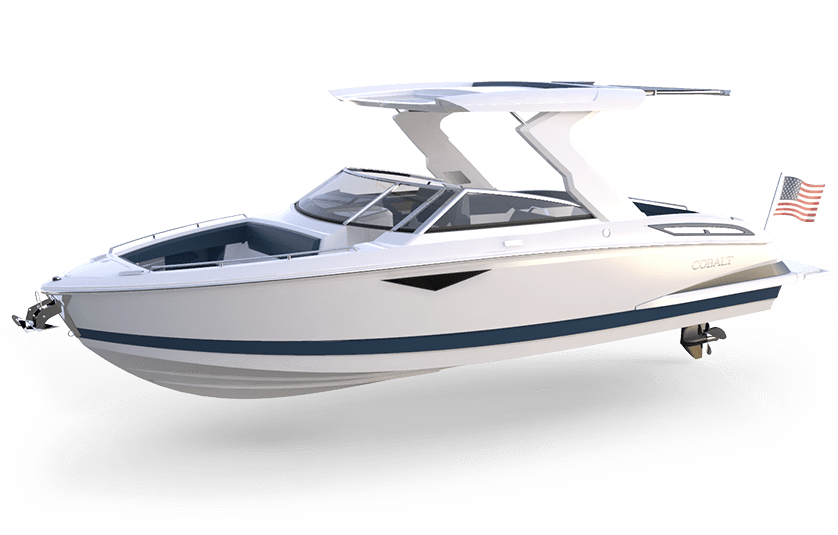
- Day Cruising
- Wakeboarding
- At Anchor In-Water Activity
- Large Bodies of Water
- Small Bodies of Water
- Overnight Aboard
For those who want all the versatility of a sterndrive with enhanced surf boat capabilities, the Surf Class is the perfect choice. In three easy steps, you’ll have the ideal wave for your family’s surfing success. And all of this with no trade-offs in your cruising enjoyment.
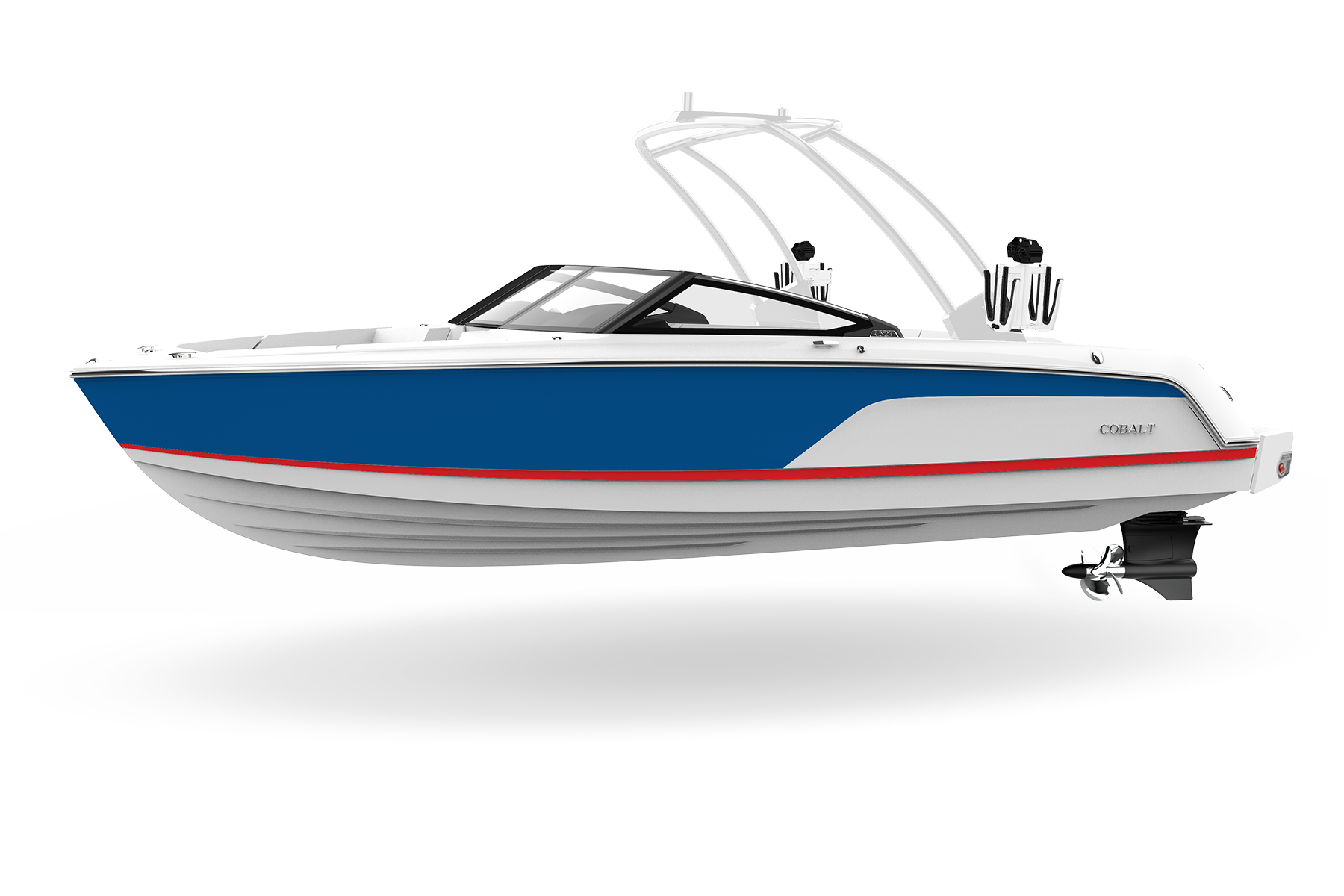
The Outboard Class offers powerful cruising with a modern quiet ride. Great in saltwater, these outboard boats are engineered for efficiency, ease of maintenance, and year-round readiness with a variety of power options.
The Coastal Edition is designed with a comprehensive set of features specifically tailored for saltwater protection and durability. Boaters can navigate with confidence, knowing that the boat is equipped to handle the elements effectively.
Our Coastal Edition features the highest quality stainless steel components, watertight electrical connectors, innovative water management system, GPS mapping with coastal maps, carpet-free floor storage, redundant bilge pump system, and self-bailing cockpit (R6 models and above).
- Outboard Class

- Explore All
- Owner Experiences
- Cobalt Innovations
- Coastal Edition
- Monsoon Engines
- News & Events
- Our Company

- Design Your Dream
- Find a Dealer
- Full Line Brochure Request
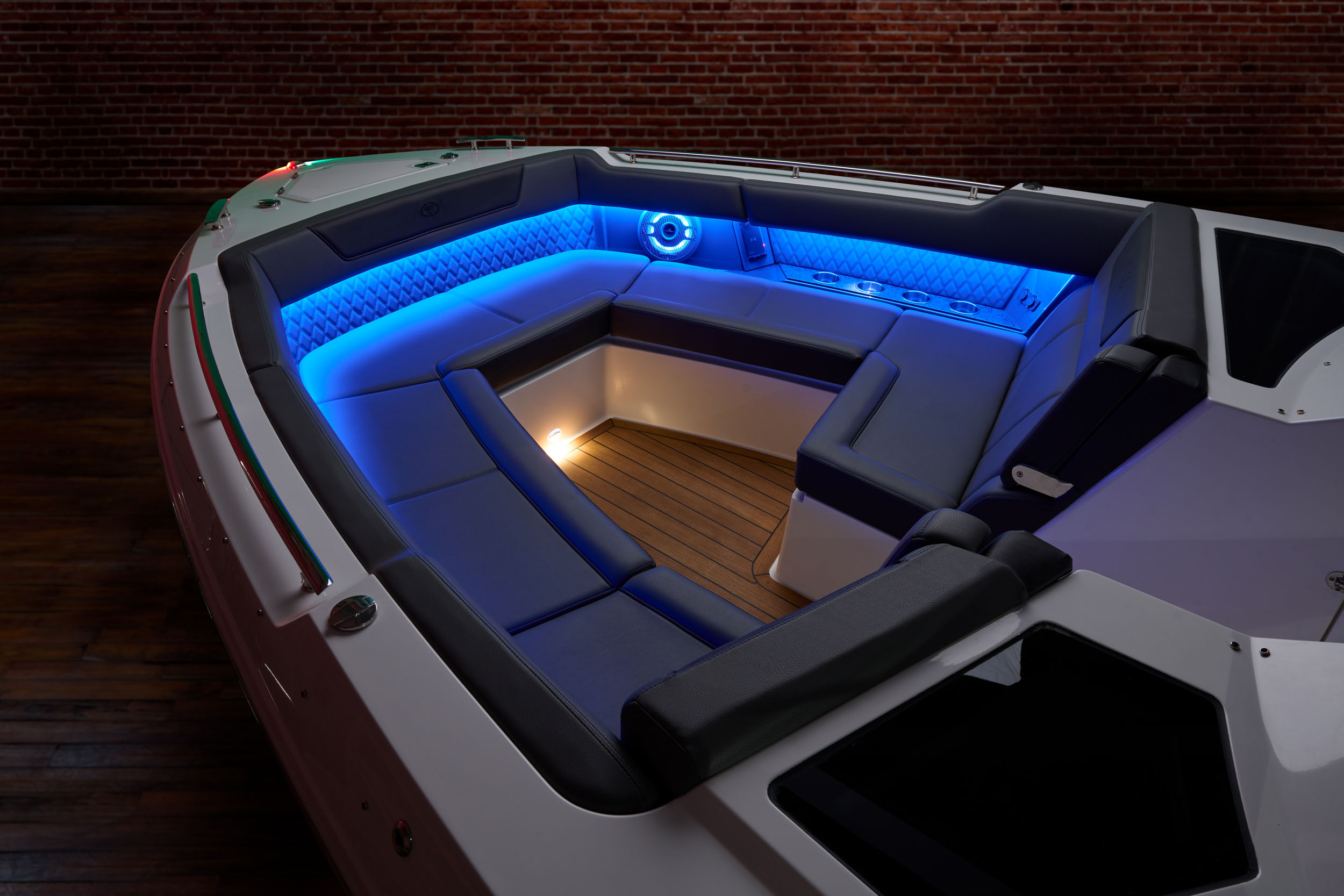
Yacht Certification
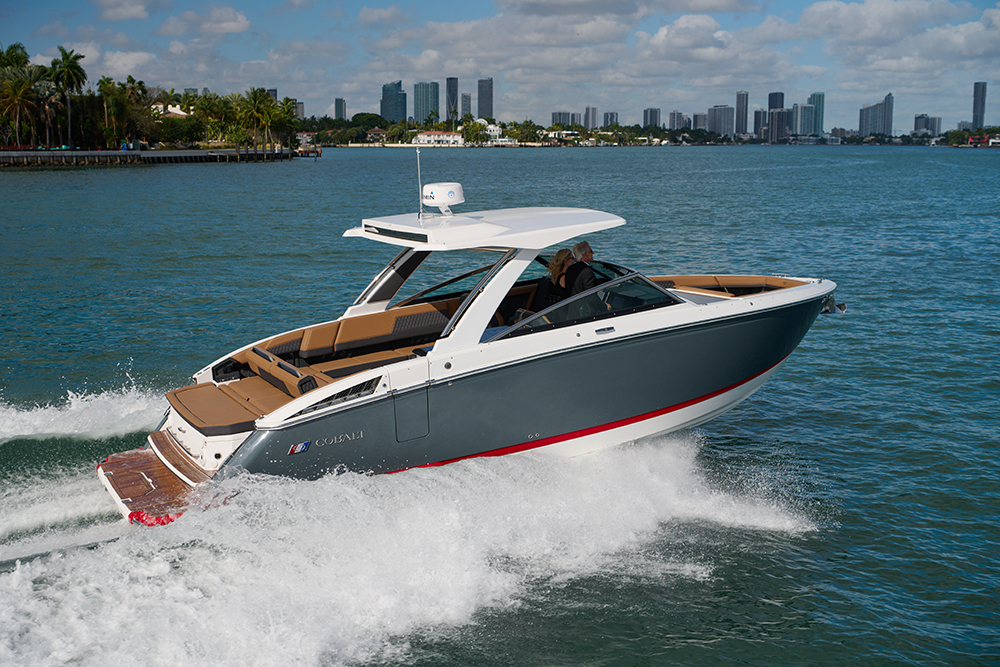
Is It Only About Size?
Did you ever wonder at the term ‘Yacht Certified’ when you see it listed in the ‘Capacity’ category for many Cobalt boats? If so, here’s what it’s really about, and it goes way beyond the number of people a boat can carry safely.
Boats, Yachts, and Ships
First, let’s start with the definition of a yacht, which is often described as a boat that’s 35 feet or more in length. At the extreme, a yacht can range in size to more than 200 feet, which also brings up the discussion of the difference between a boat and a ship (fun fact: the definition of a boat is that it leans into a turn, while ships heel outward in a turn.)
For our purposes, though, the term ‘yacht’ as used by the National Marine Manufacturing Association (NMMA) refers to boats that are 26 ft. or longer, which gets to the heart of why a pleasure-boat owner might want to know what goes into their yacht certification.
How the Yacht-Certified Placard Benefits You
“Yacht Certification” is a manufacturing quality standard implemented by the NMMA under a vetting process established by the American Boats & Yacht Council. The advantage of this for boat buyers – including Cobalt owners, of course, since every yacht-certified Cobalt model goes through NMMA recertification each year – is that many boat manufacturing processes are tested and inspected during manufacturing by a trained representative of a neutral, independent certifying body.
Comprising a physical inspection of critical safety items, from bilge pumps to fuel tanks, horns, lights and steering components, yacht certification shows that a manufacturer is committed to meeting and exceeding a higher quality standard.
The Comforts of Consistency
One immediate benefit of yacht certification is, of course, knowing these boats don’t have a defined passenger capacity. But there are other comforts of having a consistent set of certification standards.
Such as the fact that there are thousands of trained technicians who develop and oversee these tests, helping to ensure that any manufacturing issues can be immediately identified and resolved on the factory floor. Or that yacht-certified boats are 7 times less likely to experience a safety recall. Or that the yacht-certification program provides boat manufacturers with an established structure for tracking the customer experience, as well as participating in the Marine Industry Customer Satisfaction Awards Program.
Built To A Higher Standard
In short, yacht certification is another way to ensure that Cobalt boats are built to the highest industry standards, so Cobalt owners can enjoy the level of superior, consistent quality that they – and we – expect.

If you’re interested in learning more about boatbuilding, we’re ready to help! Contact us with your question and we’ll be glad to share the answers with your fellow Cobalt owners!
Related Posts
Better Sailing

Sailboat Vs Yacht: What is The Difference?
Many boaters use the terms “sailboat” and “yacht” interchangeably when they are actually quite distinct. A yacht is a larger boat or ship that is used for recreational purposes. The term “yacht” is of Dutch origin, and it was initially described as a small, swift sailing vessel used by the Dutch navy to track down and catch pirates. A boat, on the other hand, is a smaller vessel that can range from a fishing boat to a sailboat in size. So, if you’re interested in this topic, this article will compare yachting with sailing in many ways. Like this, you will have a much better understanding of which option is best for you. Keep reading!
Sailboats and Yachts: Meaning
Firstly, it’s important to understand the meaning of each word. Generally, a boat is a form of watercraft that comes in a variety of shapes and sizes. A boat is a watercraft that is small enough to fit on a ship, which is typically less than 1,000 feet long. A ship is a huge vessel with a large carrying capacity that can transport other vessels. The size, shape, and capacity of a boat vary depending on its intended usage. Boats are most commonly employed for navigating places along the water’s edge or inland waterways like lakes and rivers, although they can be utilized on any water source. Boats can be used for a variety of purposes, including providing service to people and vessels on the water, recreational activities, commercial passenger, and cargo transportation across waterways.
So, a sailboat (sailing vessel) is a boat that is propelled primarily by the force of the wind on sails. Keep in mind that the term “boat” can cause some misconceptions about the vessel’s size. People may refer to it as a sailing ship rather than a sailing boat once it reaches a particular size. Also, boats are generally thought to be smaller than ships. A sailboat is a water-borne watercraft whose principal means of propulsion is the wind, which is captured and controlled by triangular-shaped pieces of cloth known as ‘sails.’ On the other hand, a powerboat is a watercraft with an internal combustion engine as its primary source of propulsion.
A yacht is most likely a vessel that is primarily used for personal rather than business purposes. There are yachts that you can hire for a week or more. This might add a little confusion as they are commercially owned but within the hire period, they are used by individuals for leisure purposes. Generally, people usually refer to sailboats as yachts or vice-versa. This is a common phenomenon nowadays, however, there are significantly more sailing yachts than motor yachts at the seaside/marina. If you want to specify a boat that is not largely powered by the wind, use the word motor yacht.
Sailing yachts and motor-powered yachts are the two forms of yachts available today. Yachts range in length from 26 feet to hundreds of feet. A cabin cruiser, or just a cruiser, is a luxury vessel that is less than 39 feet long. A superyacht is typically above 70 feet long. So, what is the definition of a mega yacht? They usually exceed 150 feet in length, but there is no top limit! Note that the world’s largest boat is 728 feet long, or 222 meters.
Let’s now check the main differences between a sailboat and a yacht:
Sails and Motor
The boat may be powered purely by the wind or by one or more inboard or outboard motors, depending on the model. While some larger boats may have very massive engines to provide genuine speed on the water, most yacht engines are far less powerful. Yacht engines are substantially larger, can produce far more power – up to 800hp in some circumstances – and can go many further distances.
If you’re searching for a vessel that’s easier to operate, you could argue that a yacht is a superior option. Sure, the computer components are more complicated, and there is more to manage, but sailing will be simpler. In stormy weather, managing a sail can be tricky. From inside the cabin, you can’t manage your sails. You may, however, operate your yacht from the cabin.
It’s a fact that sailboats will always have sails. After all, it’s their primary source of propulsion. The nail is what propels the boat forward by harnessing the wind. So long as the weather permits, sailing can be done anywhere, at any time. Yachting, on the other hand, has its own set of restrictions. A yacht will usually lack a sail, which can be viewed as a good or negative aspect, depending on your perspective.
The advantage of having a sail over only an engine is that you don’t have to worry about running out of fuel. Fuel is not only costly but also inconvenient and pollutes the environment. When on long voyages, you must always keep an eye on your fuel levels, or you risk breaking down at sea. The great thing with sailboats is that as long as there is wind, a sailboat can sail. If you have an extra sail onboard, you should be alright regardless of what occurs. You have a significantly lower chance of being left stranded at sea.
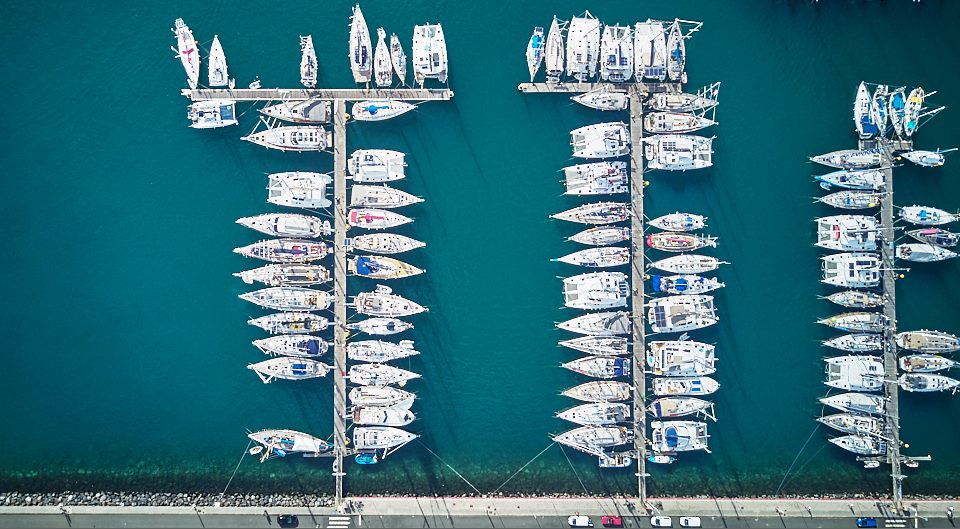
>>Also Read: Sailboats Vs Powerboats: Why Sailboats are Better
Size Matters
The size difference between a yacht and a sailboat is one of the most significant ones. Most of the time, a sailboat will almost certainly be smaller than a yacht. Of course, some sailboats are larger than others, but if we’re talking about average sizes, a yacht will be larger. The reason that size counts so much when deciding which boat to buy is that the available space is limited. So, if you opt for space note that the larger your boat is, the more space you’ll have. This may seem self-evident, but it is one of the most crucial aspects of your boat to which many people forget to give due consideration.
Generally, when it comes to boats, size will always matter. Except in cases where someone prefers overall better performance and speed. But, keep in mind that almost everything you do will be influenced by the size of your boat. The smaller the boat, the less storage space you have, the less space you have for emergency supplies, and even the less space you have for yourself. Regardless of the size of your boat, your sleeping quarters will most certainly be small. Also, depending on your height, every inch of a room may be crucial.
When there are more people on your boat than just you, size matters the most. If you intend to live alone on your yacht, you will have a significant space advantage. If there are three persons on board, you probably going to need more equipment and devices for cooking or for emergencies. All of this suggests that the sleeping space is the most significant distinction between living alone and living with people. If you live alone on a yacht that can sleep four people in theory, you will have a lot more storage and consequently space.
People on Board
The extent to which the crew will influence your decision is mostly determined by your budget and the size of the vessel you are considering buying. Meaning that if you’re intending to buy a sailboat, you won’t need any crew. Except for your family/friends that live on your boat with you, you basically are the entire crew. However, if you own a yacht, it’s an entirely different scenario.
If you intend to live aboard your yacht, you may require the assistance of one or two crew members. There will be plenty to do even if you are the most essential member of the team, i.e. the captain. This is because you might haven’t already mastered things like navigation, maintenance, plumbing, and engineering. So, a yacht often requires a complete crew to assist with navigation, maintenance, electronics and engineering, repairs, and sometimes even stewards to attend to the passengers.
In other words, having a sailboat means that you can take care of everything yourself. There are only a few computer components that will need to be repaired, and you are unlikely to have an engine. Repairing a sailboat isn’t easy in and of itself; it’s just easier for one person to handle. Meaning that it’s far easier to replace a sail than it is to fix an engine. In bad weather, a small sailboat is just easier to monitor than a large yacht. At the absolute least, another set of eyes will be probably required when sailing with a yacht.
Price also Matters
In general, yachts tend to be more expensive than sailboats. Occasionally, a great deal more. For a variety of factors, the most important of which are materials, design, and construction techniques. Note also that a boat’s price is likely to rise as it becomes more modern. Although this isn’t always the case, it is the vast majority of the time. If money is a key factor in deciding which boat to buy, here’s something to think about: just because a yacht is more expensive doesn’t mean you shouldn’t have one. If you have the cash, knowledge, and you know the kind of sailing you will be doing then go for a yacht!
Note also that a sailboat can be outfitted with a variety of amenities and conveniences. But, the sailboat doesn’t always include these features. This will mostly depend on the type of sailboat. As a result, buying a basic sailboat can save you a lot of money. However, most yachts will provide high end amenities. As a result, a motor yacht will cost significantly more than a regular sailboat. Sailboats are also smaller than yachts, which means you have a larger selection of less expensive boats to pick from when making your purchase. But, yachts often start in the six-figure range and can reach millions of dollars depending on the yacht’s size, age, and build quality.
Maintenance and Repairs
Yachts are frequently more expensive to maintain than sailboats. Meaning that boat engines require a great deal of upkeep, and the expense of fuel can be prohibitive for many individuals. For example, did you know that a gallon of diesel fuel in a yacht may only allow you to travel less than 1 nautical mile? If you’re going on a long voyage out to the sea, you can end up spending a lot of money on fuel. A sailboat, on the other hand, can take you wherever you want to go with very little fuel. Bear in mind also that a yacht’s insurance is more expensive than that of a sailboat. One of the main reasons is because it is classified as a yacht.
In addition to the boat’s price there are some other things to consider. The most important one is maintenance and repairs. A boat will always need these and it might need them once per month or once per year. It depends on the kind of repairs and on the way in which you “treat” your boat. Also, if you’re buying a used sailboat, you will need sometimes more research and more money for upgrades. It will be repainted, restored, and upgraded, although it will remain the same size. You should approach buying a boat in the same way that you would with a car. So, according to the size and kind of boat you want to buy, it’s important to keep in mind the price and extra costs as well.
While advanced marine electronics and navigation systems are available on some boats, they are more of a must for yachts. When doing transatlantic voyages, it is critical not only to be able to navigate with precision but also to be able to identify other boats or objects that you may not be able to see, as well as to comprehend your vessel’s performance.
When it comes to technology, it’s not just about whether you’re choosing a sailboat or a yacht. The age of the specific vessel is also something to consider. A sailboat that is more than ten years old may not be as technologically advanced as a brand new sailboat. Better technology can offer a lot of opportunities for you if you decide to buy a yacht. First and foremost, it can make working on your boat much more convenient. There’s no reason you couldn’t work remotely from your boat if you have the ability to set up a functional office with wifi.
Technology also brings up a lot of new possibilities for you when it comes to the act of sailing. A sailboat could traverse the Pacific or Atlantic, but it would be rather difficult. On the other hand, with a yacht, it can be a lot easier. In comparison to a sailboat, your yacht will have advanced navigational systems, warning and guidance systems, and many more safety features.
Sea, Lakes, or Rivers?
Bear in mind that in shallow waters, large yachts are unable to sail. A sailboat is a way to go if you plan on sailing in areas with shallow waters. In the Caribbean, for example, a yacht might be difficult to navigate. At the very least, it’ll be more difficult than sailing. A yacht, on the other hand, may travel to far more places than a sailboat.
A small sailboat might theoretically sail across the Atlantic. However, it can be quite risky, and your boat might not be able to withstand the strong winds and waves. Furthermore, if you’re aboard a sailboat, you can be the only one on board. This means that if the worst happens, far out at sea, there will be no one to aid you. You can do it, of course, but it is risky.
So, smaller boats may normally operate in calmer seas such as lakes, rivers, and shallow harbors. Larger boats, usually between 20 and 30 feet long, can equally navigate rougher ocean seas. A yacht, on the other hand, can sail in deeper ocean waters and handle more choppy seas. Yachts are significantly more ideal for lengthy ocean voyages due to their bigger size, high-tech electronics and guidance equipment, weather protection, and a variety of other characteristics.
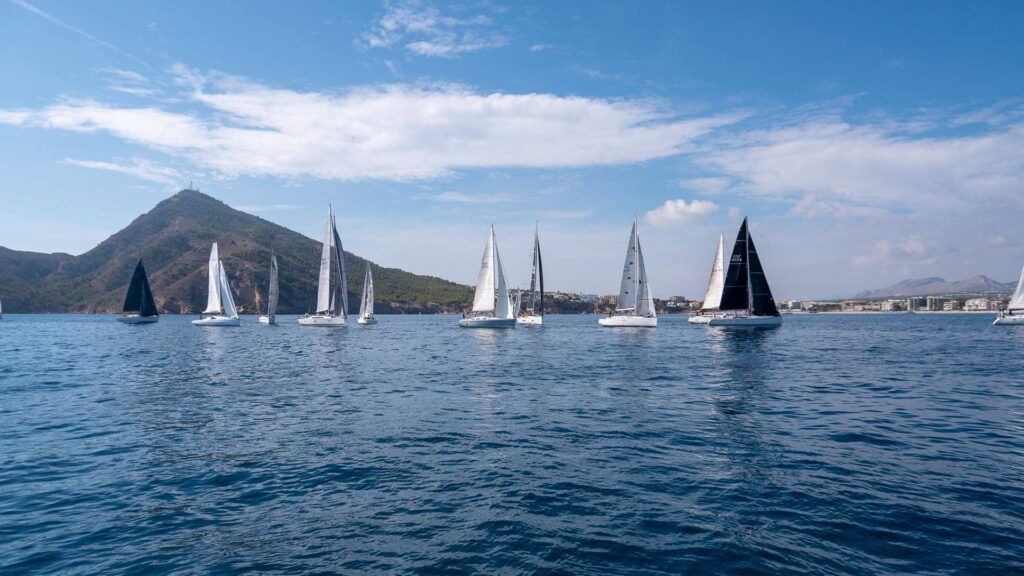
>>Also Read: Sailing Vs Boating: Why Sailing Is Better
Sailboat and Yatch Construction
Depending on the anticipated scale of production, sailboat makers can fabricate their own parts or order them. Masts, sails, engines, and metal fittings are common items provided by specialty vendors. Boatbuilders, on the other hand, create their own fiberglass hulls, using Gel coat polyester resin, a catalyst for the resin, woven fiberglass roving, and fiberglass. Wooden hull manufacturers create and shape their own wood in the same way. Note that the main building materials used in boat construction are aluminum, metal, wood, and fiberglass. The unique structure of each material offers a different design and usage as well as additional features to the way in which the boat is built.
Material considerations are important, whether they affect the cost or the durability of the product. Fiberglass, carbon fiber, and metals such as titanium will also be used to construct a boat. On the contrary, a sailboat will most likely be composed of wood or fiberglass. So, in case you value safety and sturdiness above all else, and money isn’t a big issue, a yacht will be significantly safer for you.
The material can also influence the way in which you make repairs. For instance, a wooden boat is much easier to repair than a metal boat. You can make some simple and quick repairs using wood, and they’ll probably last till you get to a marina. To do major repairs on a yacht, you’ll need a lot of specialized equipment and knowledge. Moreover, you may need to ask for a crew member to help you with this.
Sailboat Vs Yacht – Summary
As you can see there are many differences between a sailboat and a yacht. Nowadays many people tend to confuse or don’t be aware of the exact meaning and differences of these vessels, and it’s normal. But, we, as sailors, have to know the differences in order to understand which kind of boat is right for us. For example, if you want big spaces, luxury, or intend to liveaboard then you should opt for a yacht. But, if you want to experience the true joy of sailing, sail anywhere without worrying about polluting the environment or spending too much on fuel, then go for a sailboat! It will entirely depend on your needs and preferences so weigh the pros and cons of each one before making the decision.
In any case, I hope that you have now clarified the differences between these two and that you will make the right choice. I wish you all safe & enjoyable voyages!
Peter is the editor of Better Sailing. He has sailed for countless hours and has maintained his own boats and sailboats for years. After years of trial and error, he decided to start this website to share the knowledge.
Related Posts

Atlantic vs Pacific: Which is More Dangerous for Sailing?

The Ultimate Guide to Choosing the Best Fishing Line for Trolling

Lagoon Catamaran Review: Are Lagoon Catamarans Good?

Best Inboard Boat Engine Brands
- Buyer's Guide
- Destinations
- Maintenance
- Sailing Info
Hit enter to search or ESC to close.
Ita Yachts Canada
Brokerage / Courtage
Demystifying yacht classification A, B, C, D
N.B. For your information, a more recent article was published on 24 Oct 2022 on the same subject, click here for direct access.

Demystifying yacht classification : Class A, B, C and D
Since 1998, CE certification is required for all recreational boats entering or being sold in Europe obliging boat manufacturers to respect certain building and security standards. Therefore, yachts ( boats ) are classified into four categories depending on their aptitude to confront navigational conditions taking into account both force of the wind and height of the waves. The categories are not to limit the area and distance of navigation (that is defined by security equipement onboard) but to sensitize the owner and/or captain of the boats capacities to navigate in complete security.
Let us start with the Beaufort Scale. A scale for classifying the force of the wind ranging from 0 (calm) to 12 (hurricane). It was devised by an admiral in the British Navy, Francis Beaufort, to uniform the description of the effect of different winds at sea.
There is a direct link between the Beaufort scale and boat classification. For discussion purposes, we will use only the 6, 7 and 8 forces.
A Class A yacht ( boat ) is a vessel that is built to navigate the open ocean and surpass a force 8 on the Beaufort scale and surpass waves higher that 4 meters. These yachts are constructed to be self sufficient in hostile seas.
A Class B yacht ( boat ) is a vessel built to navigate on the offshore waters (200 miles and less) and can substain UP TO force 8 and waves UP TO 4 meters.
A Class C boat is a vessel built to navigate inshore such as lakes, rivers, bays and close to the shore and can sustain UP TO force 6 and waves UP TO 2 meters.
A Class D boat is built for protected or sheltered waters such as canals, rivers, small lakes and sustain a force 4 and waves UP TO .3 meters (less that 1 ft).
With this said, you can understand that the Class A yacht ( boat ) respects a rigorous building code more so than a Class B and so forth. But regardless of the class, it is strongly discouraged to navigate in a force 7 for the reasons of safety and comfort as « pleasure » should always be on the agenda. Always consult the weather forecast prior to leaving any port and check hourly the weather situation.
Classification is very important and should be on your question list before purchasing any boat or yacht.
Classification rules are developed to assess the structural strength and integrity of the essential parts of the hull, the reliability and function of the propulsion, steering systems, power generation and all the other features installed on board which contribute to guarantee the main essential services of yacht.
Also for a class A, the portholes will be more resistant against a sustained wave, the drains to evacuate the water more abundant and of good size, the joints of the hull more hermetic, in short everything is in place to prevent water from s’ infiltrate on board.
By way of information, let us quote for example all the Ferretti yachts (60 to 96 feet), Pershing (60 to 115), the Riva (44 to 122) are all of class A just like the Magellano range at Azimut including also the 66 Flybridge.
Ferretti yachts (500, 550, 670 fly and over), Pershing (7X and over), Azimut Yachts (62, 64, 66, 68 Fly and over, the Sport Series 7X and over, all Magellano) are Class A. There are also other classifications such as RINA and American Bureau of Shipping, Bureau Veritas, Det Norske Veritas, Germanischer Lloyd, Lloyd Register, that are more precise regulations and we will cover this later in another article.
Below is the graph of the Beaufort Scale along with photos.
Do not hesitate to contact us for any additional information, team Ita Yachts Canada is at your disposal.

Share this:
Published by Guy Bolduc
View all posts by Guy Bolduc
Leave a Reply Cancel reply
Discover more from ita yachts canada.
Subscribe now to keep reading and get access to the full archive.
Type your email…
Continue reading
- CATAMARAN MOTEUR
- CATAMARAN VOILE
- CENTER CONSOLE
- FISHING BOAT
- SPORT BRIDGE
- ABSOLUTE YACHTS
- CRUISERS YACHTS
- FOUNTAINE PAJOT
- GRAND BANKS
- KADEY-KROGEN
- MOCHI CRAFT
- MINIGHT EXPRESS
- MONTE CARLO
- NORTHERN MARINE
- OCEAN ALEXANDER
- OUTBACK YATCHS
- PARDO YACHTS
- PRESTIGE YACHTS
- SILENT YACHTS
- $1,5 M to $2,9 M
- $3,0 M to $4,9 M
- $5,0 M to $6,9 M
- $7,0 M to $9,9 M
- $10,0 M and more
- UNDER 49 FEET
- 50 to 59 FEET
- 60 to 69 FEET
- 70 to 79 FEET
- 80 to 89 FEET
- 90 to 99 FEET
- MORE THAN 100 FEET
- CENTRAL AMERICA
- PERSIAN GULF
- UNITED-STATES OF AMERICA
- YACHTS REGISTERED UPDATED
- VIRTUAL TOUR 3D
- YACHTS FOR SALE
- IMPORT-EXPORT
- BLOGUES, NOUVELLES ET CONSEILS
- PODCAST VIDEO
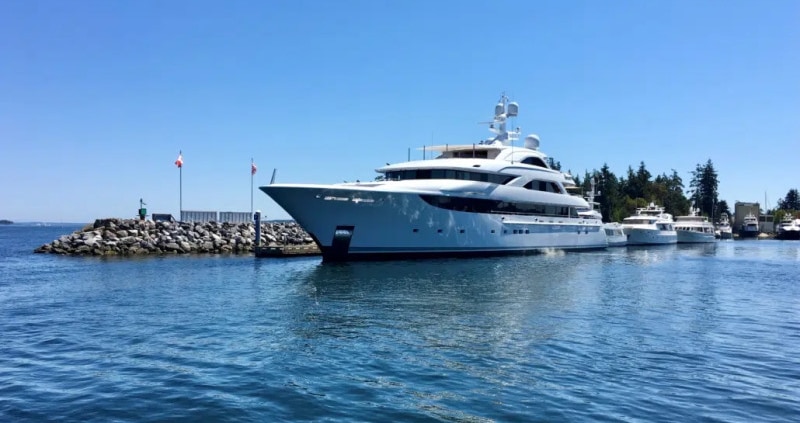
What is a Yacht? History, Types of Yachts, Styles, and Sizes
In this article, we explain the definition, history and origin of the word yacht, and break down some of the more common types of yachts along with various styles and sizes.
Yacht Definition & Origin
The word yacht comes from the Dutch word “jacht”, which means to hunt, and refers to the quick and lightweight sailboats the Dutch navy used to pursue pirates and other enemies in shallow waters. Today, the word takes on a very different meaning. While there is no strict definition of the word today, a yacht is generally considered as a boat used for pleasure, whether you’re cruising open waters, racing or island-hopping for the weekend. Typically, we consider a boat to be a yacht if it has an overnight cabin onboard, is more than 33 feet long, and generally looks nicer than your average vessel.
Pleasure boats have been around for hundreds of years, which is no surprise when you consider our options for transportation around that time. Without planes, cars, bikes or scooters, humans turned to the one form of transportation they knew well for pleasure – the ship.
Sailing Yacht History
Sailing yachts have been a thing since at least the beginning of the 1660s in Europe, when King James of England commissioned a sailing yacht for his son Henry, the Prince of Wales. But it was Charles II, the Kind of Scotland, who brought the term “yacht” into the mainstream after spending time exiled in the Netherlands. Once Charles got home, he began commissioning royal yachts left and right.
Steam Yacht History
Steam Yachts also have quite the history, which started as massive and luxurious sailing yachts with steam auxiliary engines. These yachts were much larger, and carried full crews complete with a cook, captain, engineer, stewards and deck hands. By the late 1700s, screw propellers were installed and the engines became far more efficient. Eventually, compound engines came about and persisted until the internal combustion took over.
Power Yacht History
Powerboats with 4-stroke gas engines were first developed by Nicolaus Otto and Gottlieb Daimler in 1876. Then in the 1900s, diesel engines became the more popular option because of their lower cost and improved reliability.
Yacht Types
Today, yachts fall into one of two general categories – sailing yachts and motor yachts.
Sailing Yachts
A sailing yacht is a leisure craft that relies on its sails for the primary method of movement, made from natural, synthetic or carbon fibers. Sailing yachts are split into two main categories: cruisers and raisers.
Cruising Yachts
A cruising yacht is designed for comfort above anything else. These yachts are ideal for overnight and lengthy journeys, typically equipped with all the comforts of home, including full kitchens (galleys), bathrooms (heads) and beds. They’re also designed to be slightly easier to maintain.
At the smaller end, we have what’s called as a “trailer sailer”. These yachts are generally shorter than 25 feet, and can be pulled by the average car. But anything shorter than 33 feet is considered a small sailing yacht. The next level is 33-45 feet, referred to as near-shore yachts. Offshore yachts are the largest category, including vessels larger than 45 feet.
Racing Yachts
A racing yacht is designed with performance top of mind, rather than comfort. World Sailing, the governing body for the sport of international sailing, recognizes 11 different classes of sailing yachts, but each share some general characteristics.
On a racing yacht, aerodynamics is prioritized. These yachts come in a variety of shapes and weights, but performance is the underlying motivation for all. Similar to aerodynamics but underwater, hydrodynamically efficient hulls allow boats to pull through the water with minimal drag or extra motion. Finally, for peak performance, these sailing yachts typically use full-battened Kevlar or carbon fiber sails.
Motor Yachts
Motor yachts come in all shapes and sizes, built with a variety of different materials. Generally speaking, they range from 30-130 feet in length, but there are superyachts out there exceeding 500 feet (that’s over 150 metres!).
The hull of a motor yachts comes in three basic styles. A yacht with a full-displacement hull moves the water up and away, creating waves. These boats have the potential to be plenty powerful, but their speed is limited. Semi-displacement hulls are slightly faster, because they’re able to partially rise above the water. Last are the yachts with a planing hull. These yachts are the fastest, because of a flat underside and enough power to lift them onto the surface of the water.
The majority of modern motor yachts have at least one diesel engine. A boat with two engines is certainly more expensive, but well worth it when you consider the reliability and increased handling/performance.
When it comes to motor yacht styles, there are many. Here’s a brief introduction to a few different motor yacht styles:
- Sport Motor Yacht : These powerful crafts are built with a semi-displacement and planing hulls, making them fast boats great for weekend adventures and short trips.
- Trawler Motor Yacht : A trawler is known for its more traditional style with a displacement hull, designed for medium distance passage-making.
- Cruising Motor Yacht : A cruising yacht is built for comfortable longer distance travel, equipped with a displacement hull.
- Expedition Yacht : Similar to a cruising motor yacht, expedition yachts are built with a displacement hull for long distances, but these crafts specialize in passage-making in remote areas.
- Mega Luxury Yachts : The mega luxury yachts is what you see and hear about on TV and in magazines. They’re hundred of feet long, designed for dozens of family and friends, and reserved for the super-rich.
- Sports Fisherman Yacht : These yachts have semi-displacement or planing hulls for quick fishing trips where you need to be able to move well. On a sports fisherman yacht, there will also be extra space for fishing gear and large fish.
- Lobster Yacht : A lobster yacht is similar to but quicker than a trawler, built with a semi-displacement or planing hull. These yachts get their name from their unique style – looking like classic Maine lobster boats.
If you’re looking for a new yacht, browse our current listings of sailing and motor yachts at Van Isle Marina. You can also visit us in Sidney at 2320 Harbour Road to see our stock in person, and our staff will be happy to help you out.
250 656 1138
2320 Harbour Road, Sidney, British Columbia V8L 2P6 [email protected]
Marina Services
Marina Layout
Yacht Sales
- Link to Facebook
- Link to Instagram
©2024 Van Isle Marina | Design by Caorda


Brahmatal Trek: Get Ready For The Most Immersive Experience In Uttarakhand

How to Travel Long Distances in Tactical Gear: A Comprehensive Guide

Unlocking the Island Adventures of Madeira with No-Deposit Car Rentals

Villa vs Apartment – Your Guide of Choosing Right Home

5 Ideal Rentals for Families: Comfort and Convenience Combined

5 Great Budget-Friendly Rentals For A Memorable Getaway
Sorry, but nothing matched your search " ". Please try again with some different keywords.
A Beginner’s Guide To Understanding Yacht Types And Sizes
Feb 13, 2023
Travel Guides
When it comes to buying a yacht, there are many different factors to consider.
One of the most important is understanding the various types and sizes of yachts available on the market. With so many options to choose from, it can be overwhelming for a first-time yacht buyer.
This beginner’s guide will help you understand the different types of yachts and their sizes, so you can make an informed decision when buying your first yacht .
Before we dive into the different types and sizes of yachts, it’s important to have a good understanding of what is available on the market. To get started, check out a list of yachts for sale in various locations . This will give you an idea of the types of yachts that are available and their prices.
Yacht Types
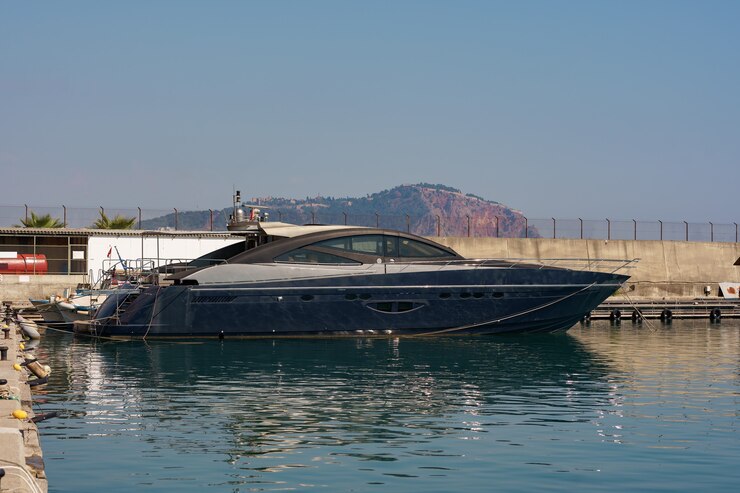
1. Motor Yachts
Motor yachts are powered by engines, and they are designed for luxury cruising. They come in a variety of sizes and styles, ranging from smaller, more intimate vessels to larger, more spacious yachts that can accommodate several guests.
2. Sail Yachts
Sail yachts are powered by the wind and are perfect for those who want a more adventurous boating experience. They are typically larger than motor yachts and offer more space for guests to relax and enjoy the scenery.
3. Catamarans
Catamarans are two-hulled vessels that are known for their stability and comfort. They offer spacious cabins, large outdoor areas, and plenty of room for guests to relax and enjoy the surroundings.
4. Power Catamarans
Power catamarans are similar to catamarans, but they are powered by engines. They are perfect for those who want the stability of a catamaran, but with the speed and convenience of a motor yacht.

5. Trawlers
Trawlers are designed for long-distance cruising and are known for their spacious interiors, comfortable cabins, and excellent fuel efficiency. They are perfect for those who want to explore distant destinations and enjoy extended periods at sea.
Yacht Sizes

A. Small Yachts
Small yachts are typically less than 40 feet in length and are perfect for short trips and intimate gatherings. They are ideal for those who want a simple, low-maintenance vessel that is easy to handle.
B. Mid-Size Yachts
Mid-size yachts are typically between 40 and 80 feet in length. They offer more space and amenities than small yachts, and they are perfect for those who want a comfortable and spacious vessel for extended trips.
C. Large Yachts
Large yachts are typically over 80 feet in length and offer an unparalleled level of luxury and comfort. They are perfect for those who want the ultimate boating experience, with spacious cabins, large outdoor areas, and top-of-the-line amenities.
Perks Of Buying A Yacht
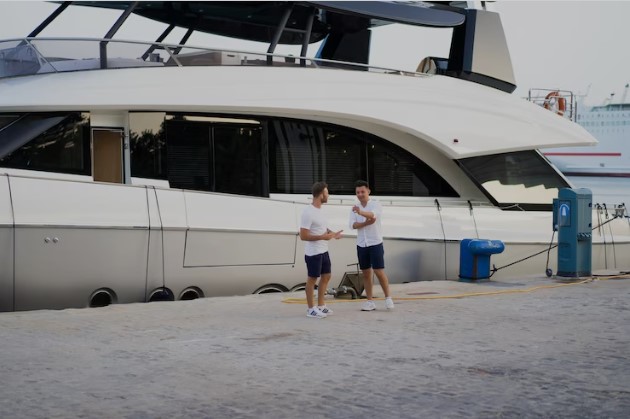
1. Freedom and independence
With a yacht, you have the freedom to travel to any location you choose and set your itinerary. You have the independence to spend time on the water and explore new and exotic destinations.
2. Privacy and exclusivity
Yachts offer a level of privacy and exclusivity that is difficult to find on land. You can escape the crowds and enjoy your own space, away from the hustle and bustle of everyday life.
3. Luxury and comfort
Yachts are designed for luxury and comfort, with high-end amenities and spacious living quarters. You can relax in comfort and style, and enjoy all the amenities you would expect from a five-star hotel.
4. Adventure and excitement
Owning a yacht opens up a world of adventure and excitement. You can go fishing, diving, and exploring, and experience new and exciting destinations.
5. Increased social status
Owning a yacht is often seen as a symbol of success and social status, and can be a great way to network and make new connections.
6. Investment Opportunity
Yachts can also be a wise investment, as they often hold their value over time and can generate rental income if you choose to charter your yacht.
7. Quality family time
Spending time on a yacht can provide quality family time and create unforgettable memories. It’s a great way to bond and connect with loved ones while experiencing new and exciting destinations.
There are many beautiful places you can visit on a yacht, depending on your preferences and interests.
Listed Below Are Some Of The Destinations That Are In High Demand:

A. Mediterranean
The Mediterranean is one of the most popular yacht destinations in the world, offering stunning scenery, warm weather, and a rich cultural heritage. You can visit countries like France, Italy, Spain, Greece, and Turkey, and experience their unique history, architecture, food, and wine.
B. Caribbean
The Caribbean is a popular destination for yacht enthusiasts, offering crystal-clear waters, white sand beaches, and a warm and relaxed atmosphere. You can visit islands like the Bahamas, Barbados, Saint Lucia, and the Virgin Islands, and enjoy activities like snorkeling, diving, and island-hopping.
C. Maldives
The Maldives is a breathtaking destination for yacht enthusiasts , offering a remote and unspoiled environment, with pristine beaches, vibrant coral reefs, and abundant marine life. You can explore the atolls, relax in the sun, and enjoy the tropical paradise that is the Maldives.
D. South Pacific
The South Pacific is a popular destination for yacht enthusiasts, offering a remote and exotic environment, with lush tropical landscapes, turquoise waters, and abundant marine life. You can visit countries like Fiji, Tahiti, and the Cook Islands, and experience their unique culture, history, and natural beauty.
E. Thailand
Thailand is a popular destination for yacht enthusiasts, offering stunning beaches, tropical landscapes, and a rich cultural heritage. You can visit the famous islands of Phuket, Koh Samui, and Koh Phi Phi, and experience their stunning scenery, vibrant nightlife, and tropical paradise.
When it comes to buying a yacht, understanding the different types and sizes of yachts is essential. From small and intimate vessels to large and luxurious yachts, there is a type and size of yacht that is perfect for everyone. With this guide, you will be well on your way to making an informed decision when it comes to buying your first yacht.
- Travel To Turkey
- 12+ Best Hamilton Island Restaurants: Must Visit In 2023!
- Top Luxury Escapes Bucket List Ideas For Wanderlust Jetsetters
- buying a yacht
- convenience of a motor yacht
- first-time yacht buyer
- luxury yacht
- luxury yacht charter
- sizes of yachts
Share on Social Media
Arnab Day is a passionate blogger who loves to write on different niches like technologies, dating, finance, fashion, travel, and much more.
Leave a reply cancel reply.
Your email address will not be published. Required fields are marked *

Top Reasons To Host Corporate Events On Yacht

Essential Guide To Choosing Motorcycle Gear For Every Rider

The Most Exclusive Summer Destinations in Italy

Top Five Treks in Nepal
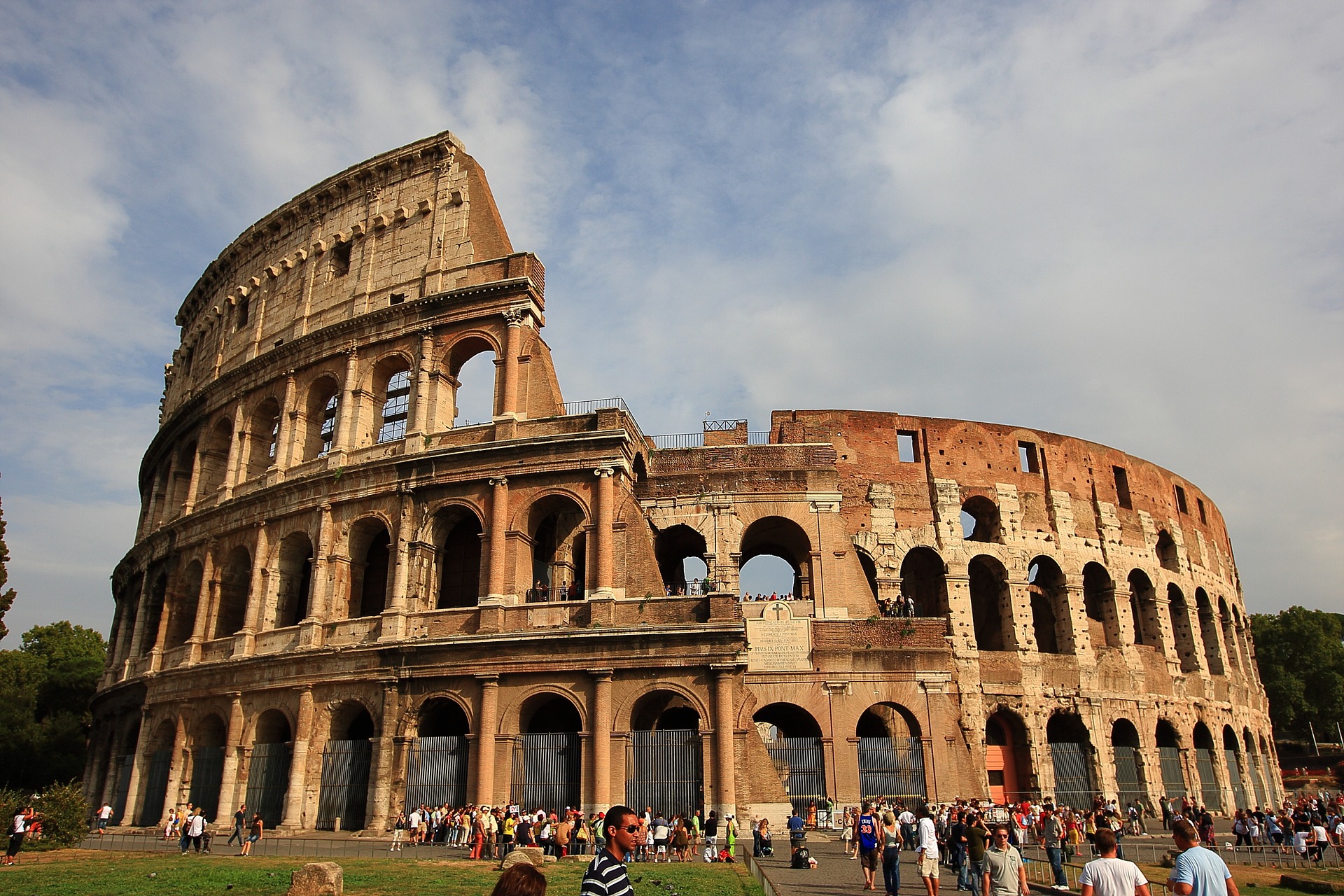
The New Seven Wonders of the World

10 Famous Temples in South India for a Spiritual Journey

Top Sahara Desert Countries You Should Visit

- Subscribe Now
- Digital Editions

Yacht definitions: What is a yacht? And does it need to have sails?
- Top stories
By far the most common question we get asked here at Motor Boat & Yachting is ‘how can you call that a yacht if it doesn’t have sails?’ Here we explain why a boat doesn’t need sails to be called a yacht...
What’s in a name? Quite a lot if you’re a yacht! Not only are the names of yachts a source of endless amusement, but by defining your boat as a yacht in the first place, you’re setting up certain expectations.
Yacht definitions: A brief history
Whilst boating for fun dates back to Ancient Egypt and possibly even further than that, the word yacht comes from the Dutch ‘jachtschip’, which means hunting ship. Jachts were originally a class of sailboat used in the 16th century to hunt down enemies of the Dutch Republic.
However by the 19th century the term ‘yachting’ had developed to mean recreational boating in general, and with the advent of steam boats, sails were no longer the only method of propulsion available to Victorian yachtsmen.
Article continues below…

World’s largest superyacht: Everything you need to know about 183m REV

Hemingway’s boat reborn: How Pilar was recreated in meticulous detail
Recommended videos for you.
In the early 20th century (1904 to be precise), our humble magazine was launched under its original title The Motor Boat , but by the 1950s the ‘& Yachting’ suffix had been added to refer to the general pastime enjoyed by motorboat owners. We even reviewed the occasional motorsailer for those who liked to enjoy the benefits of both power and sail.
Today’s Motor Boat & Yachting is dedicated purely to powered leisure vessels from 25-125ft with the occasional foray above and below that when interest dictates. Current editor Hugo Andreae insists that he is ‘terminology agnostic’ saying, “I’m not bothered whether people refer to their boats as yachts, cruisers, power boats or gin palaces just so long as they enjoy using them. But for the record my 22ft Karnic is definitely a gigayacht!”

Editor Hugo’s Karnic 2250 is his family’s pride and joy, but should it be called a yacht?
What makes a yacht, a yacht?
Some would argue that a yacht has to have sails, and as we’ve seen, that was originally the case, but we here at Motor Boat & Yachting beg to differ, as its common to refer to large motorboats as motoryachts, superyachts or even megayachts without any expectation that they would have sails.
Others assert that a yacht should have to have a cabin in order for it to be fully considered a yacht, or that it has to measure at least 10m in length. If that’s the case then some longer narrowboats could be technically considered as yachts, although you’d be hard pushed to find anyone who agrees with that definition.
The final test for something to be considered a yacht is harder to pin down, but it is generally accepted that all yachts have to have a certain aesthetic or architectural appeal in order to earn this haughty moniker.

The advent of internal combustion in the 19th Century allowed motor yachts, like this fine example from Camper & Nicholsons, to be launched. Photo: Getty Images
Whether a boat is worthy of being called a yacht is clearly subjective, but there’s one thing we won’t budge over – it certainly doesn’t have to have sails!
If it’s sailing yachts specifically that you’re interested in, you won’t find many of them here, but we can heartily recommend our sister titles Yachting Monthly and Yachting World , who know much more about them than we do.
Bigger yacht definitions: Superyacht, megayacht or gigayacht?
Beyond the simple term yacht, there are a few other yacht definitions worth clarifying. The most commonly used of which is superyacht .
The debate still rages over what constitutes a superyacht. Any pleasure yacht with a load line length of 24m or more (not length overall or waterline length as is often misquoted) and a gross tonnage of 80GT is classified as a Large Yacht under MCA coding rules, causing a number of additional regulations to kick in, most crucially the requirement for the skipper to hold a commercially endorsed Yachtmaster Offshore Certificate. This is the closest thing to a technical definition of a superyacht.
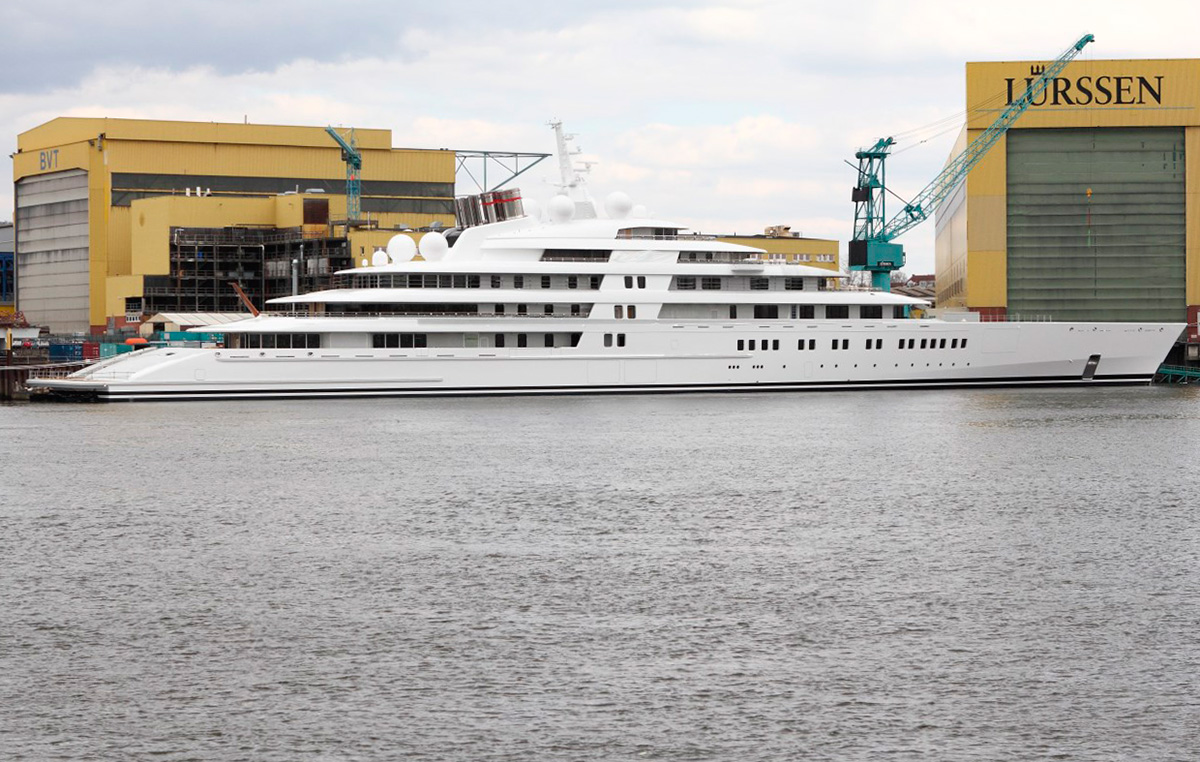
At 180m Azzam is currently the largest yacht in the world, but an 183m gigayacht called REV is currently under construction in Norway. Photo: Wikimedia Commons
However, while this used to mean most leisure boats with an overall length (LOA) of 80ft or more fell into the Large Yacht category, yards have become so adept at designing bigger boats with a load line length of just under 24m that many craft with an LOA of 90ft or more still count as regular pleasure vessels.
For that reason some people prefer to use the simpler definition of a superyacht being any privately owned vessel with an LOA of 100ft or more. Even then some would argue that a true superyacht should be a custom built yacht of at least 35m or 120ft.
Such is the inflationary pressure on yacht sizes and terminology that the term superyacht itself has begun to lose currency among the yachting elite. Owners of craft over 50m now use the term megayacht to categorise their larger vessels, while the lesser-spotted gigayacht is reserved for yachts over 100m.
Fewer than 100 gigayachts have been built to date, making this the rarest of rare breeds. That said with the world’s largest yacht now measuring over 183m, it’s surely only a matter of time before the 200m mark will be broken and yet another term will be needed. Got any suggestions? Drop us an e-mail: [email protected]
Lifejacket may have saved boater after fall from motor boat
Boats at southampton boat show: sunseeker ocean 156, new boats at cannes boat show 2024: pearl 82, latest videos, watch: parker sorrento sea trial: 50-knot cruiser with a killer aft cabin, watch: virtue v10 sea trial: €272k weekender, how to mark your anchor chain: 6 top tips from our expert, watch: galeon 560 fly sea trial – the best galeon flybridge you can buy.

QUALITY CONTROL MEASURES IN BOAT BUILDING
In the realm of boat building, quality isn’t merely an aspiration; it’s a necessity. With a sharp focus on safety, durability, and performance, quality control becomes the bedrock upon which each boat is constructed. This article delves into the key aspects that make up the quality quotient in boat manufacturing.
Importance of Quality Control in Boat Building
Quality control is not just one step in making things; it’s a belief that’s everywhere. The need for meticulous quality control in boat building is imperative for ensuring the long-term safety and performance of the vessel. With varied marine conditions, the tolerance for error is minimal, making quality control an indispensable aspect.
Material Storage
-Fiberglass:
Storing fiberglass in a controlled environment ensures that the material maintains its structural integrity, free from moisture and contamination.
Aluminum requires specific storage conditions to prevent oxidation and maintain its well-known strength and durability.
-HDPE (High-Density Polyethylene):
HDPE storage needs to protect the material from UV radiation to maintain its resistance to impact and environmental conditions.
Material Testing
Before entering the manufacturing process, materials go through rigorous tests for tensile strength, impact resistance, and corrosion resistance. This phase is critical to ensuring that only high-quality, reliable materials are used in building the boat.
Craftsmanship and Skilled Labour
The human touch remains invaluable. Skilled craftsmen bring decades of experience to the table, specializing in various construction techniques that contribute directly to the quality of the final product.
Training and Certification
Staff training and certifications ensure that the workforce is equipped with the latest skills and knowledge. It is crucial that skilled labor is not just experienced but also certified by relevant authorities to guarantee a high-quality output.
Manufacturing Processes and Techniques
Hand-laid vs. Vacuum-infusion
Both hand-laid and vacuum-infusion techniques have their merits and are chosen based on the specific requirements of the boat. The former offers more hands-on control, while the latter promises a more uniform distribution of resin.
-Welding Standards
Quality welding is foundational in boat building, particularly in aluminium & HDPE constructions. Adherence to welding standards ensures strength and longevity.
Quality Control Protocols
-In-process Inspections
Regular in-process inspections are conducted to identify and rectify any deviations or defects as they occur.
-Final Quality Checks
Before the boat leaves the factory, it undergoes final checks to ensure that every aspect, from the engine to the navigation system, meets the required quality standards.
Safety Measures and Protocols
Adhering to stringent safety protocols is non-negotiable. This includes fire safety measures and ensuring that the electrical systems are up to code, among other considerations.
Class Compliance
Class compliance with maritime authorities ensures that the boat meets all the industry standards, including safety, environmental impact, and performance metrics.
Final Testing and Validation
The last stage in the quality control process involves extensive testing, often including sea trials. These final tests serve to validate that the vessel performs according to specified parameters under a variety of conditions.
Conclusion:
The quality in boat building is a multi-faceted endeavor involving meticulous planning, skilled craftsmanship, and rigorous testing. By adhering to established protocols and standards, manufacturers can deliver boats that are not just impressive to look at but also safe, durable, and high-performing. Quality is, indeed, the true north that guides the ship of boat building to excellence.
Click here to read about “ CHOOSING THE RIGHT MATERIAL: HDPE Vs FRP Vs ALUMINUM “
Follow my LinkedIn newsletter here: “LinkedIn Newsletter”
0 comments Leave a reply
Save my name, email, and website in this browser for the next time I comment.
Recent Posts
- KEY LESSONS I LEARNED FROM MY FREELANCE JOURNEY IN 2023
- THE FREELANCE ECONOMY: KEY TRENDS AND PREDICTIONS FOR 2024
- THE RISE Of HDPE IN BOAT MANUFACTURING: TRENDS & BENEFITS
- THE CRITICAL ROLE OF FEASIBILITY STUDY IN BOAT DESIGN AND NAVAL ARCHITECTURE
- THE CHALLENGES Of SMALL CRAFT DESIGN COMPARED TO LARGER VESSELS
Recent Comments
- Casey Lim on HDPE BOAT PLANS
- BRYN BONGBONG on HDPE BOAT PLANS
- Keith on HDPE BOAT PLANS
- Daniel Desauriers on WHY HDPE BOATS?
- December 2023
- November 2023
- October 2023
- February 2023
- January 2023
- September 2022
- January 2021
- ARTIFICIAL INTELLIGENCE
- boatbuilder
- BOAT CONSTRUCTION TECHNIQUES
- BOAT DESIGN COST
- boatdesign process
- CAREER PATHWAYS
- COMMERCIAL BOATS
- conventional boats
- custom boat
- DESIGN ADMINISTRATION
- DESIGN SPIRAL
- EXTREME CONDITIONS
- FEASIBILITY STUDY
- Freelance advantage
- freelance boat designer
- FREELANCE ECONOMY
- FREELANCE JOURNEY
- FRP Boat without Mold
- HDPE Collar
- INDIA'S MARITIME
- INVENTORY MANAGEMENT
- ISO STANDARDS
- Mass Production
- Monhull vs Catamaran
- Naval Architect
- Naval Architecture
- PLANING HULL
- Project Management
- Proven Hull
- PSYCHOLOGY OF BOAT DESIGN
- QUALITY CONTROL
- RECREATIONAL BOATS
- RISE OF HDPE
- ROYALTY AGREEMENTS
- SANDWICH VS SINGLE SKIN
- SOLOPRENEUR
- YACHT DESIGN COURSE

The global authority in superyachting
- NEWSLETTERS
- Yachts Home
- The Superyacht Directory
- Yacht Reports
- Brokerage News
- The largest yachts in the world
- The Register
- Yacht Advice
- Yacht Design
- 12m to 24m yachts
- Monaco Yacht Show
- Builder Directory
- Designer Directory
- Interior Design Directory
- Naval Architect Directory
- Yachts for sale home
- Motor yachts
- Sailing yachts
- Explorer yachts
- Classic yachts
- Sale Broker Directory
- Charter Home
- Yachts for Charter
- Charter Destinations
- Charter Broker Directory
- Destinations Home
- Mediterranean
- South Pacific
- Rest of the World
- Boat Life Home
- Owners' Experiences
- Conservation and Philanthropy
- Interiors Suppliers
- Owners' Club
- Captains' Club
- BOAT Showcase
- Boat Presents
- Events Home
- World Superyacht Awards
- Superyacht Design Festival
- Design and Innovation Awards
- Young Designer of the Year Award
- Artistry and Craft Awards
- Explorer Yachts Summit
- Ocean Talks
- The Ocean Awards
- BOAT Connect
- Between the bays
- Golf Invitational
- BOATPro Home
- Superyacht Insight
- Global Order Book
- Premium Content
- Product Features
- Testimonials
- Pricing Plan
- Tenders & Equipment
Yacht classification definitions
The merchant shipping sector is ruled by safety regulations developed since the beginning of the 20th century, and is familiar with international conventions such as SOLAS, MARPOL and Load Lines. But the application of common safety requirements to pleasure vessels is something relatively new – a continuous work in progress – and is very much dependant on the service and the flag of the yacht.
Defining the problems
Definitions do not help. How often have we read of large yachts, superyachts, megayachts, gigayachts or other bombastic adjectives? How many times have we mentioned MCA, RINA, and Lloyd’s, without having a clear idea of who’s doing what?
A good starting point for understanding the subject is to clarify the main definitions and the roles of the main players:
Large yacht
A large yacht is a pleasure vessel with a load line length equal to or over 24m. Almost all the flag administrations have adopted safety codes dedicated to large yachts and this is, therefore, the only definition having a universal meaning in the international regulatory framework of yachts.
Commercial yacht
A motor or sailing vessel in commercial use (i.e. charter) for sport and pleasure, carrying no cargo and not more than 12 passengers.
Private yacht
A pleasure vessel solely used for the recreational and leisure purpose of its owner and his guests.
Flag administration
The government of the state whose flag the yacht is entitled to fly . This administration sets the safety regulations, manning requirements and fiscal aspects relevant to the yacht registration.
Different flag administrations can inspect the safety aspects of yachts with their own inspectors (see MCA for example) or delegate this activity partially or totally to other recognised bodies such as the classification societies.
The main flag authorities in the yachting industry are: The UK-MCA, Cayman Islands, Isle of Man, Malta, the Marshall Islands, Italy and Luxembourg.
Classification societies
Organisations that establish and apply technical standards in relation to the design, construction and survey of ships.
Classification rules are developed to assess the structural strength and integrity of the essential parts of the hull, the reliability and function of the propulsion, steering systems, power generation and all the other features installed on board which contribute to guarantee the main essential services.
In addition to this ‘third party check’ function, class societies carry out statutory duties on behalf of the major flag administrations in accordance with specific delegation agreements signed with each government.
The main class societies involved in yachting are: American Bureau of Shipping, Bureau Veritas, Det Norske Veritas, Germanischer Lloyd, Lloyd’s Register, and RINA.
Large yachts: Applicable rules and certificates
Private yachts
The mandatory requirements for these boats are very light. For the majority of flag states, a registration survey and a tonnage measurement, carried out by an authorised surveyor, are sufficient.
The only mandatory international conventions are those relevant to the marine environment: MARPOL and the Anti-Fouling System Convention.
The International Convention for the Prevention of Pollution from Ships (MARPOL) is intended to eliminate the intentional pollution and to minimise the accidental pollution of the marine environment caused by harmful substances.
The Anti-Fouling System Convention’s purpose is to eliminate the presence of harmful substances for the marine environment contained in anti-fouling paints applied to ships.
Classification
While classification is not mandatory, building and maintaining a private yacht in class is the only evidence that the boat has been designed, constructed and operated in compliance with appropriate technical standards. It is therefore highly desirable, especially in relation to insurance and re-sale purposes.
Commercial yachts
All flag administrations require commercial yachts to be certified in accordance with a specific large yacht safety code.
The most popular of these safety codes, and the first that was developed, is the MCA Large Commercial Yacht Code (LY2) published in 2004. It replaced the Code of Practice for the Safety of Large Commercial Sailing and Motor Vessels (LY1) published in 1997.
LY2 is applied by the Red Ensign Group Flags (UK, Cayman Islands, Isle of Man, Bermuda, Gibraltar, British Virgin Islands, etc.) and is recognised as a reference standard for all the yachting industry.
Other flags have developed similar codes. Luxembourg, Italy, Marshall Islands, Malta, Belize and The Netherlands are some examples.
While introducing a stricter set of rules and regulations compared to private yachts, commercial registration offers yacht owners the possibility of making a profit from the chartering activity of their boats, and allows them to take advantage of all the other benefits of a commercial operation (in particular VAT exemption on the purchase, sale, bunkering, provisions, dry-docking, and others).
Mandatory certificates
The number and type of the mandatory certificates depends on the size of the vessel; the following is an indicative list:
- International Tonnage Certificate : A measurement of the internal volumes of the yacht expressed in gross tons (GT). This measurement should not be confused with displacement tonnage, which quantifies the weight of a vessel.
- Large Yacht Code Certificate : Covers life-saving appliances, fire protection and means of escape, navigational and signalling equipment, intact and damaged stability, manning and crew accommodation.
- Class Certificate : This mainly deals with the yacht’s hull, machinery, electrical equipment and outfitting.
- International Load Line Certificate : This certifies the weather-tightness of the yacht.
- Safety Radio Certificate : This is applicable if gross tonnage exceeds 300GT This concerns the radio communication and distress installations.
- MARPOL Annex I Certificate : This is applicable if gross tonnage exceeds 400GT This deals with the disposal of oil and bilge water from machinery spaces.
- MARPOL Annex IV Certificate : This is applicable if gross tonnage exceeds 400 or the yacht is certified to carry over 15 persons. This deals with the disposal of sewage from ships.
- MARPOL Annex V : This is applicable to all ships. It covers the disposal of rubbish.
- MARPOL Annex VI : This is applicable if gross tonnage exceeds 400GT as well as to all main and auxiliary engines with a power exceeding 130kW. It concerns the emissions from main and auxiliary engines (NOx and SOx).
- Safety Construction and Safety Equipment : These are additional prescriptions on machinery, electrical parts, life-saving and navigational equipment for yachts with a gross tonnage above 500GT.
- International Safety Management Certificate : This is only applicable to yachts having a gross tonnage greater than 500GT. A certified management company is requested to carry out this service, preparing operational manuals, procedures for drills, and taking care of the maintenance of the yacht and its installations.
- International Ship and Port Security Certificate : This is only applicable to yachts having a gross tonnage greater than 500GT and deals with the anti-piracy certification. A certified management company is requested to provide the ashore assistance and establish on-board procedures and operational manuals.
The GT Factor
The gross tonnage value (GT) is a key issue, not only as a reference for the registration fees applied by the different flag administrations, but also because it determines whether an international convention, rather than a particular safety standard, applies to a yacht.
The table below summarises how the conventions and relevant certificates come into force depending on the gross tonnage of the yacht. In particular, the following values may have a critical impact:
300GT: In many codes, when you reach this value the yacht must be certified in unrestricted service (stricter requirements regarding stability, load line and life-saving appliances).
400GT: This is the threshold for almost all the environmental conventions such as MARPOL and Anti-fouling System.
500GT: This is the threshold for the application of the SOLAS Convention, meaning stricter requirements on machinery, safety systems, materials of construction, fire protection, life-saving appliances and navigational equipment. Furthermore an external certified management company is requested for the ISM and ISPS certifications.
The tonnage issue could also arise on existing yachts when undertaking major refits or modifications, in that any change to the internal volumes of the boat – such as adding enclosed deckhouses or superstructures, or modifying the hull transom or bow – will modify the tonnage value with the risk of subjecting the yacht to stricter mandatory rules.
UPDATE: Since this article was originally published, LY2 has been superseded by Large Commercial Yacht Code Revision 3 (LY3) .
Sign up to BOAT Briefing email
Latest news, brokerage headlines and yacht exclusives, every weekday
By signing up for BOAT newsletters, you agree to our Terms of Use and our Privacy Policy .
More stories
Most popular, from our partners, sponsored listings.

What Does Yacht Mean? (The Definition and History Explained)
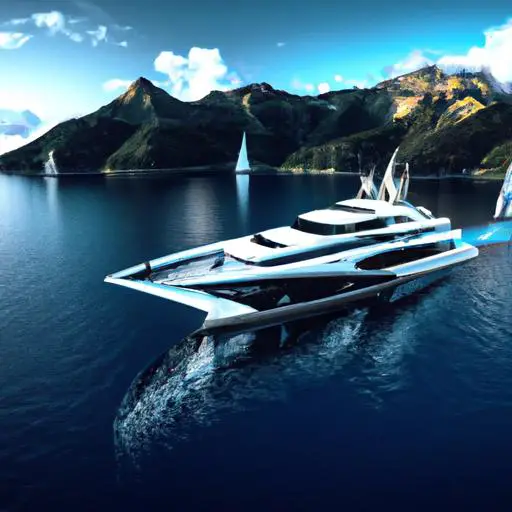
Ah, the luxurious lifestyle of the yacht.
Whether youve seen one in the harbor or on a distant horizon, the image of a yacht has a certain allure and mystique.
But what exactly is a yacht? From the definition to the different types, the history, and the lifestyle, there is so much to explore.
In this article, we will uncover the mysteries of the yacht, and explore the different types, the races, and the luxury amenities that come with them.
Get ready to set sail!.
Table of Contents
Short Answer
Yacht is a term used to describe a recreational boat or vessel that is used for pleasure trips and sailing.
It typically refers to a larger, more luxurious boat than a regular fishing or leisure boat.
Generally, yachts are meant for longer trips, usually with more than one person on board.
Yachts can range in size depending on the type of boat and its intended use, but all will typically include luxury features and amenities for a comfortable and enjoyable experience.
The Definition of Yacht
Yacht is a term often used to describe a variety of large and luxurious recreational boats, typically used for personal pleasure or sport.
Yachts can be defined as any boat or vessel that is used for leisure and recreational activities.
While the term yacht may be used to describe any kind of boat, it is most commonly used to refer to large, expensive boats designed for recreation, luxury, and leisure.
These vessels are typically larger than other recreational boats, and can range from modest day-sailers to luxury mega-yachts with all the amenities of a home.
Yachts are usually crewed by professional or paid crew and can be used for activities such as fishing, cruising, racing, and even as a floating holiday home.
Yachts may be owned either by individuals or by companies, and typically contain a variety of amenities such as staterooms, sleeping areas, dining areas, and entertainment areas.
Yachts are often used in the charter industry, where they are rented for short-term use, and can be found in harbor cities and coastal towns around the world.
Yachting is a popular recreational activity that has been around for centuries, and can be traced back to ancient Greece.
Yachting has long been associated with wealth and luxury, with the earliest yachts being owned by wealthy aristocrats.
In modern times, yachting has become more accessible to people of all backgrounds, with a variety of yachting activities and vessels available to meet a variety of budgets and preferences.
The term yacht is derived from the Dutch word jacht, which translates to hunt.
The term was originally used to refer to small, fast vessels used by the Dutch navy to chase and capture pirates.
Over time, the term has come to refer to large, luxurious recreational vessels that are often used for pleasure and leisure.
Yachts have become a symbol of wealth and luxury, and are often associated with the lifestyles of the rich and famous.
Types of Yachts

When it comes to yachts, there are several different types available.
The most common type is the sailing yacht, which is propelled through the water by sails and is typically smaller than other types of yachts.
Motor yachts, on the other hand, are powered by an engine and are typically larger than sailing yachts .
Another popular type of yacht is the sport fishing yacht, which combines the luxury of a motor yacht with the convenience of fishing.
These yachts often have advanced navigational equipment, fishing tackle, and other amenities.
Finally, there are luxury yachts, which are the most luxurious of all yachts and typically feature amenities such as jet skis, hot tubs, and full-service bars.
No matter which type of yacht you choose, they all provide a luxurious experience on the water.
Yacht Racing
Yacht racing is one of the most popular activities associated with yachts, and it has a long and storied history.
Yacht racing dates back to the 1800s and has been a popular pastime ever since.
The sport is often divided into two main categories: offshore and inshore racing.
Offshore racing involves navigating the open waters of the ocean, while inshore racing is confined to the waters near shore.
In both types of racing, yachts compete against each other to see who can complete the course in the shortest amount of time.
Yacht racing is typically governed by the rules and regulations of the International Sailing Federation, which sets out a standard for the equipment and safety of the yachts and the sailors onboard.
Yacht racing is a highly competitive sport, and it is a great way to test the skills and strategies of the crew.
There are a variety of different classes of yacht racing, ranging from small dinghies and keelboats to large ocean-going yachts.
The most prestigious class of yacht racing is the America’s Cup, which is the oldest and most prestigious sailing race in the world.
The America’s Cup has been held since 1851 and is now held every four years in a different location.
Yacht racing is an exciting and challenging sport, and it is one of the most popular activities associated with yachts.
Whether it is a day sail or a full-fledged race, yacht racing is a great way to experience the thrill of sailing and the camaraderie of the crew.
Yacht Charters & Cruising

When people think of yachts, they usually think of luxury and leisurely cruising around the ocean.
Yacht charters have become increasingly popular, allowing people to enjoy the freedom of the open seas without having to purchase their own yacht.
Yacht charters offer a variety of packages, depending on the size and amenities of the yacht, the type of cruise being taken, and the number of people being accommodated.
Chartering a yacht is a great way to explore a variety of destinations and enjoy a variety of activities, from fishing and swimming to sightseeing and sunbathing.
Yacht charters typically include a professional crew to manage the vessel, as well as a variety of amenities such as a chef, cabin crew, and a variety of water toys.
Some charter companies even offer special packages for romantic getaways, corporate retreats, or special occasions.
Safety is always a priority when it comes to yacht charters, and all vessels must adhere to strict safety regulations.
All vessels must be inspected and certified by the relevant maritime authority and must be equipped with the necessary safety equipment.
Yacht charters are typically subject to local laws and regulations and must be operated in accordance with all applicable laws and regulations.
Whether youre looking for a private escape or a unique corporate event, yacht charters offer a luxurious and convenient way to explore the open seas.
From discovering new destinations to enjoying the comforts of home away from home, yacht charters provide an unforgettable experience for all.
The History of Yachts
The term yacht has been around since the 1600s, and it has come to represent a broad range of luxurious recreational boats.
The word itself is derived from the Dutch term jacht, which translates to hunt.
In the 1600s, yachts were used for military purposes, such as scouting and patrolling.
Over time, however, the term yacht has come to refer to any large, luxurious recreational boat.
Modern yachts are typically larger than other recreational boats, and range from modest day-sailers to luxury mega-yachts with all the amenities of a home.
Yachts are typically crewed by professional or paid crew and can be used for activities such as fishing, cruising, racing, and even as a floating holiday home.
The evolution of the yacht has been quite remarkable.
In the late 1800s and early 1900s, yachts were primarily used by the wealthy and elite to show off their wealth and status.
Yachts of this era were often quite elaborate and ornate, with richly decorated decks, lavish interior spaces, and even an onboard orchestra.
As technology improved, so did the capabilities of yachts.
In the late 1920s, the modern sailing yacht was invented and became the norm, allowing for a more comfortable and efficient sailing experience.
In the mid-20th century, motor yachts were developed, making navigation and speed much easier.
By the latter part of the 20th century, yacht builders began to focus more on luxury and comfort, with modern yachts featuring amenities such as spas, fitness centers, multiple decks, luxurious cabins, and more.
Today, yachts are still seen as a symbol of wealth and status, and there is a great deal of competition in the luxury yacht market.
There are many different types of yachts to choose from, from modest day-sailers to mega-yachts that can cost millions of dollars.
Yachts of all sizes can be used for a variety of activities, from fishing, cruising, and racing, to simply enjoying the beauty of the open sea.
The Yacht Lifestyle

Yachting is more than just a leisure activity; it is a lifestyle.
From the outside, it might appear to be a glamorous and luxurious pursuit, but there is much more to it than that.
Yachting is a unique way of life that is rich in adventure, exploration, and relaxation.
It is an escape from the hustle and bustle of everyday life, allowing you to explore the world in a more intimate and luxurious way.
Yachting provides an opportunity to experience the world in a way that is both exciting and luxurious.
Whether it be racing around the world or simply enjoying the gentle breeze of a summer day, yachting is a great way to explore the world.
You can explore remote destinations, experience different cultures, and even explore the depths of the sea.
With a yacht, the possibilities are truly endless.
The yacht lifestyle is also a great way to relax and enjoy the finer things in life.
With a yacht, you can enjoy the luxury of a five-star hotel, complete with a dedicated crew to cater to your needs.
On board, you can enjoy fine dining, top-shelf drinks, and all the amenities of a luxurious hotel.
You can also take advantage of the yacht’s amenities, such as a gym, swimming pool, spa, and even a movie theater.
The yacht lifestyle also offers the opportunity to meet new people and build relationships.
With a yacht, you can travel to different ports and meet new people from all over the world.
You can also host events on board, from intimate dinner parties to large gatherings.
At the end of the day, the yacht lifestyle is about living life to the fullest.
It is about exploring the world in luxury and relaxation.
It is about creating memories that will last a lifetime.
Whether you are a racing enthusiast or simply looking for a way to escape from the everyday grind, the yacht lifestyle is an unparalleled experience that is sure to provide a lifetime of memories.
Luxury Amenities of Yachts
When it comes to luxury and comfort, yachts are in a class of their own.
From plush furnishings and spacious cabins to state-of-the-art entertainment systems and private chef-prepared meals, yachts have all the amenities of a home but with the added benefit of being able to take them anywhere in the world.
Whether you’re looking to cruise the Mediterranean, fish the Pacific, or just relax in the Caribbean, yachts are the perfect way to do it in style.
Most yachts come equipped with fully-stocked wet bars, hot tubs, and even private movie theaters, making them the perfect place to entertain family and friends.
There are also plenty of options when it comes to entertainment, from game rooms to fishing equipment, and even water-sports equipment for those looking for a more active vacation.
Yachts also come equipped with the latest navigation and communications systems, so you can stay connected with the world even when you’re out at sea.
With satellite-based communication, you can even stay connected with friends and family back home.
Finally, when it comes to luxury amenities, yachts are the perfect way to pamper yourself.
From private spa treatments to personal chefs and masseuses, yachts provide the perfect opportunity to indulge and relax in style.
Final Thoughts
Yacht is a term that has a long and fascinating history, and today there are a variety of yachts that range from modest day-sailers to luxurious mega-yachts.
Yachts can be used for a variety of activities such as racing and cruising, and also offer a unique lifestyle with various luxury amenities.
If you’re looking to experience the luxury of a yacht, consider chartering one for a special occasion or take a sailing course to learn more about the yacht lifestyle.
No matter what, you’re sure to have a memorable experience.
James Frami
At the age of 15, he and four other friends from his neighborhood constructed their first boat. He has been sailing for almost 30 years and has a wealth of knowledge that he wants to share with others.
Recent Posts
When Was Banana Boat Song Released? (HISTORICAL INSIGHTS)
The "Banana Boat Song" was released in 1956 by Harry Belafonte. This calypso-style song, also known as "Day-O," became a huge hit and remains popular to this day for its catchy tune and upbeat...
How to Make Banana Boat Smoothie King? (DELICIOUS RECIPE REVEALED)
To make a Banana Boat Smoothie King smoothie at home, start by gathering the ingredients: a ripe banana, peanut butter, chocolate protein powder, almond milk, and ice. Blend the banana, a scoop of...

- How to , INFLATABLE BOATS AND RIBS , MOTOR BOATS , News , SAILBOATS
Yacht : modern meaning of the term and types of boats
- Luca D'Ambrosio
- February 25, 2023
The etymology of the term yacht comes from the Dutch word ‘jacht’, which was used in the past to define the fast sailing vessels used to hunt down pirates along the coasts of northern Europe.
Today, the term ‘yacht’ is used to describe all recreational vessels, whether sailing or motor-powered, with at least one cabin that allows the crew to sleep on board.
There is no established definition for the length of this family of boats, but common usage tends to define a yacht as a vessel longer than 33 feet, or about 10 meters.
As mentioned above, a yacht may be equipped with sailing, motor or mixed propulsion. It can have more than one hull, and if it exceeds 25 meters it also deserves the definition of superyacht . When a yacht is over 50 meters it is called a megayacht and, more and more frequently, when it exceeds 100 meters it becomes a gigayacht.
A yacht normally flies a flag that corresponds to the country where the vessel is registered, not least because, if it does not, it may be captured and taken to the nearest port for ‘flag survey’. As far as international maritime law is concerned, the yacht is considered in all respects to be the territory of the country of the flag it flies, to whose sovereignty the crew is subject.
A yacht flying the flag of a country, unless there is well-founded suspicion of illegal activity, can only be stopped for inspection by the military vessels of that country. When a yacht enters the territorial waters of a country other than that of its flag, it is obliged to fly a courtesy flag.
This is tantamount to a declaration of submission to the navigational laws of the country in which it is sailing.
Sailing and motor-powered yachts
The first major distinction is between sailing yachts and motoryachts. The current worldwide spread of these two families has shifted decisively towards motor yachts, which make up about 75% of the total sailing fleet.
Progress and design have produced many different categories of motor yachts, so let’s discover them together.
Motoryachts
Seen from the stern, a flybridge yacht is often equipped with a “beach club”, a platform that facilitates access to the sea and on which water toys are placed or simply used for diving. A staircase, or even two symmetrical staircases, leads from this platform to the main deck. Sometimes there is a “garage” between these two staircases to house the engine room, a tender and other on-board equipment.
The main deck is characterized by the presence of a helm station, inside of which a large open-space salon houses settees and a galley. The helm station often leads below deck, also known as the lower deck, where the sleeping quarters, or cabins, are normally located.
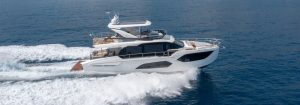
The foredeck often has a large sundeck bordered by a “bowplate” for hauling anchor. The bow is often “fenced in” by the handrails, which are vital grips for safety at sea.
Let’s get to why a yacht is called a flybridge. The flybridge is an upper deck, open 360 degrees and often covered by a hard-top, a roof usually made of fibreglass. The flybridge usually has an additional helm station to steer from a more panoramic position. An additional galley is often located on the flybridge, as well as additional lounge seating and sun decks.
Open Yachts
An open yacht has no flybridge and its main deck is commonly all open. The helm station can frequently be sheltered by a T-Top. Below deck, depending on the length of the yacht, there are living spaces for the crew which may include dinette, cabins and facilities. Open yachts can be walk-around, i.e. with the possibility for passengers of walking freely around the perimeter of the boat, or they can have an enclosed bow and thus have a raised deck.
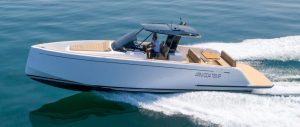
A coupe yacht is a yacht without a flybridge, characterized by a sporty design, with the main deck open aft. Very often it has a sunroof and is always equipped with side-decks connecting the stern to the bow. It is a vessel that, depending on its size, is suitable for medium to long-distance cruising.
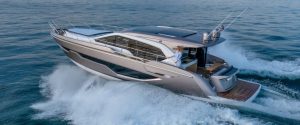
This is an important type of yacht, which has its origins on the American East Coast where it was used to catch lobsters. It has a romantic, sometimes vintage aesthetic, and is endowed with sinuous lines that, for some, are evocative of the 1950s. Very suitable for cruising and conviviality, thanks also to a large sofa in the cockpit, the lobster is an iconic boat that offers plenty of comfort and space below deck for at least one cabin and one head.
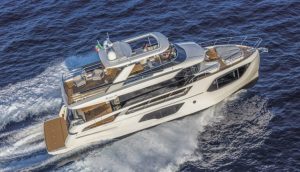
The trawler is essentially a yacht for owners who want to spend a lot of time on board. This is why interior volumes are maximized and the upper deck is always present. Also part of the trawler family are the famous Menorcan boats, inspired by the llaüts of the Menorca island..
Increasingly popular among motor yachts, too, is the multihull, due to its inherent features of stability and capacity. In most cases it is a catamaran designed for long stays at sea.
Sailing yacht
Sailing yachts are vessels where propulsion should mainly rely on the power transmitted by the wind. In the past, sailing yacht engines were low-powered and mainly used for entering and leaving ports, but today, for obvious reasons of practicality and ease of use, they have enough power to make the sailing yacht cruise at a speed at least equal to its theoretical hull speed. This means that sailing yachts can be used efficiently even in the total absence of wind.
A sailing yacht can be rigged in many different ways, these being the most common in modern times:
Sloop : this is the most common rigging on modern boats, characterized by the presence of a single mast with a mainsail and a jib or genoa. Sloop rigging has become popular over the years because it is the easiest to handle with a small crew and also offers the best ease of use/sailing performance ratio.
Cutter : Widely used for long distance sailing, it is characterized by the presence of a mainsail and two jibs rigged on a single mast. Normally the two jibs are a genoa and foresail that are used individually, depending on the weather conditions.
Ketch : this is the most commonly used rig on two-masted sailing yachts, with a mainmast, rigged with a mainsail and genoa, and a mizzenmast, forward of the rudder shaft, rigged with a single mainsail. The splitting of the sails makes this type of yacht suitable for sailing in bad weather.
Yawl : exactly the same as a ketch but with the mizzen mast located aft of the rudder shaft.
Sailing yachts can be monohulls or multihulls, i.e. catamarans or trimarans, but in all cases they can be divided into these categories:
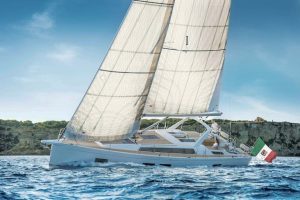
Easy to handle and with plenty of space above and below deck, this type of yacht is normally characterized by an unbalanced length/width ratio favouring the latter, a small sail area and more powerful than average engines.
The interiors are fully equipped and sophisticated, with each cabin often having its own en-suite head.
The deck plan and sailing equipment are simplified, often electrified and minimal.
Cruiser-Racer

This yacht, while still featuring a luxurious and complete interior, also has all the equipment needed for sail fine-tuning and a generous sail area.
This is a category where special attention is paid to both the overall weight of the boat and the hull shape.
The hull lines are in fact designed to enhance performance and, inevitably, this results in a slightly smaller interior than that of pure cruising yachts of the same length.
Racer-Cruiser

The owner who buys this type of yacht has already competed in club competitions and now wants to engage in higher level racing. The hulls are light and can sometimes be made of carbon, and all the sail adjustments are fine-tuned to achieve maximum performance.
The deck plan is definitely designed for crewed racing and the sail area/displacement ratio is unbalanced in favour of the former, making this yacht more difficult to handle with a smaller crew but, conversely, capable of performance similar to a pure racing yacht.
A pure racing yacht is a sailing yacht built exclusively for racing. Free from any commercial constraints, it is built according to the type of race to be competed in and, above all, the rating to be obtained. The interiors of this boat are minimal. This yacht is capable of planing and sailing upwind at very low wind angles, but is almost never used for recreational purposes.

Leave a Reply Cancel reply
Your email address will not be published. Required fields are marked *
Save my name, email, and website in this browser for the next time I comment.
Language switcher
Browse categories.

You might be interested in
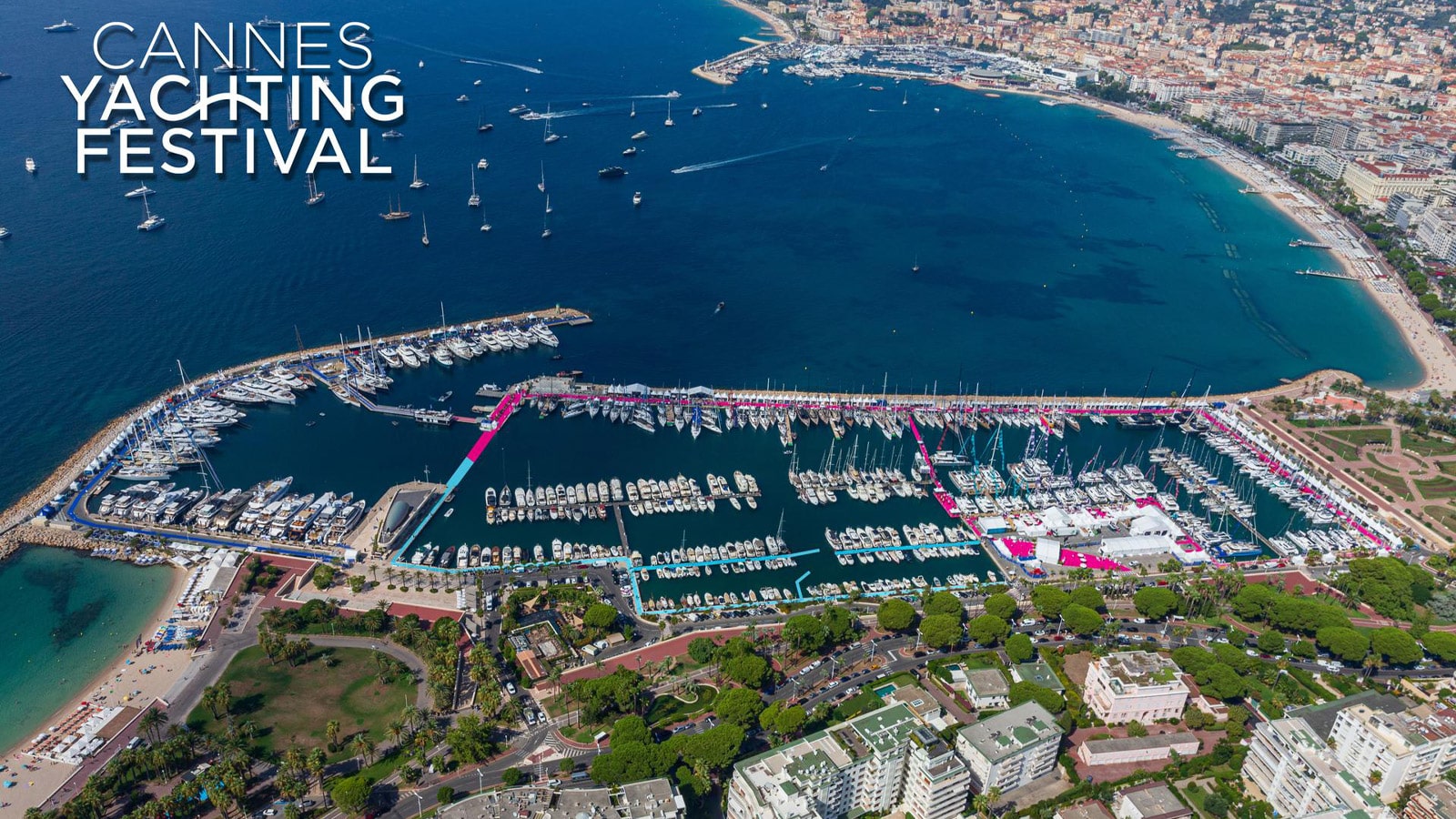
Cannes 2024 at the starting line: new highlights on display at the yachting festival
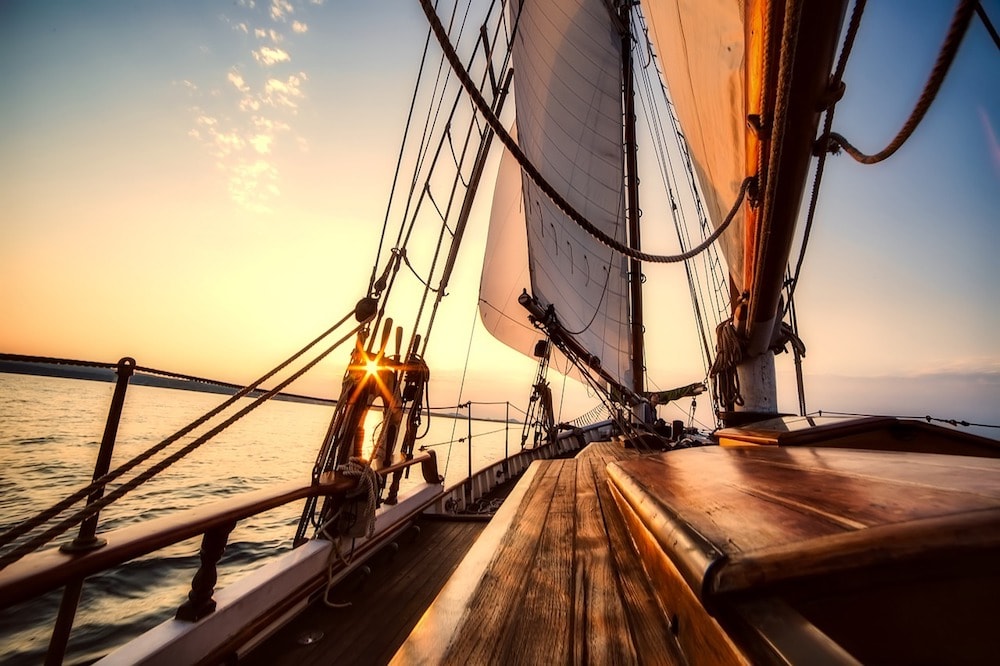
5 things not to do during a boat holiday
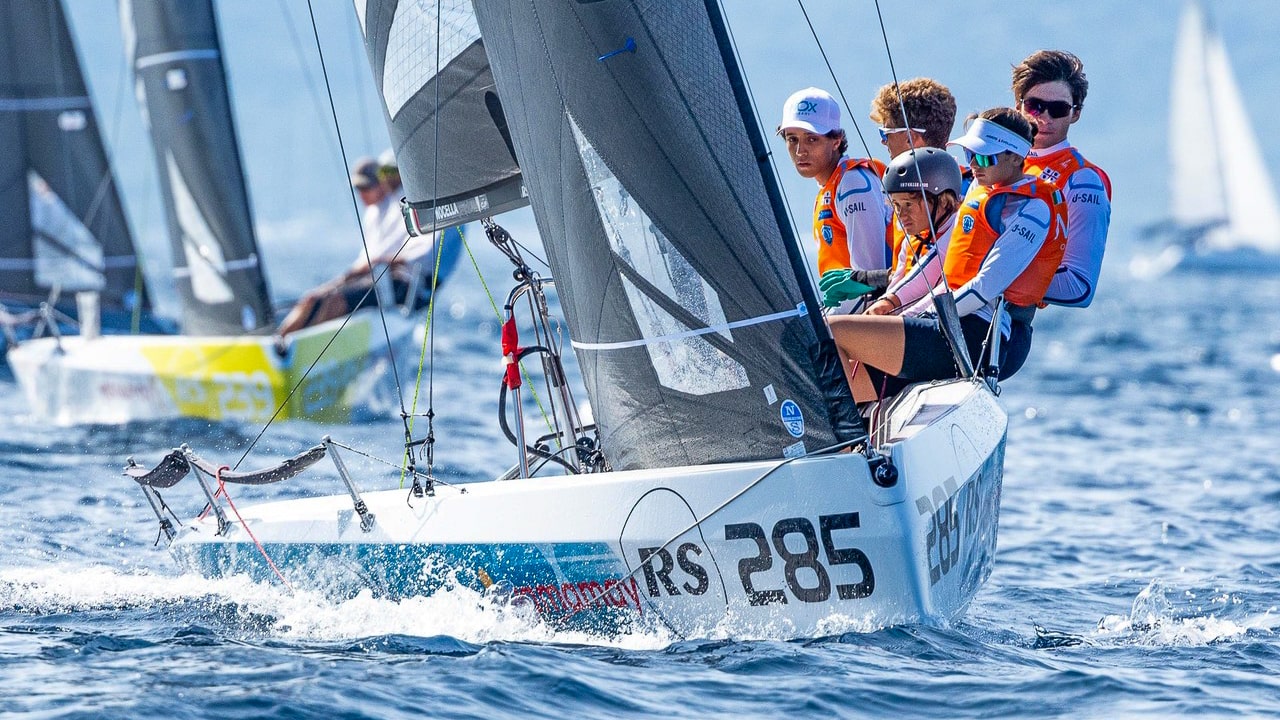
RS21 CUP: the Innovative Sailing World Championship takes place in Porto Rotondo
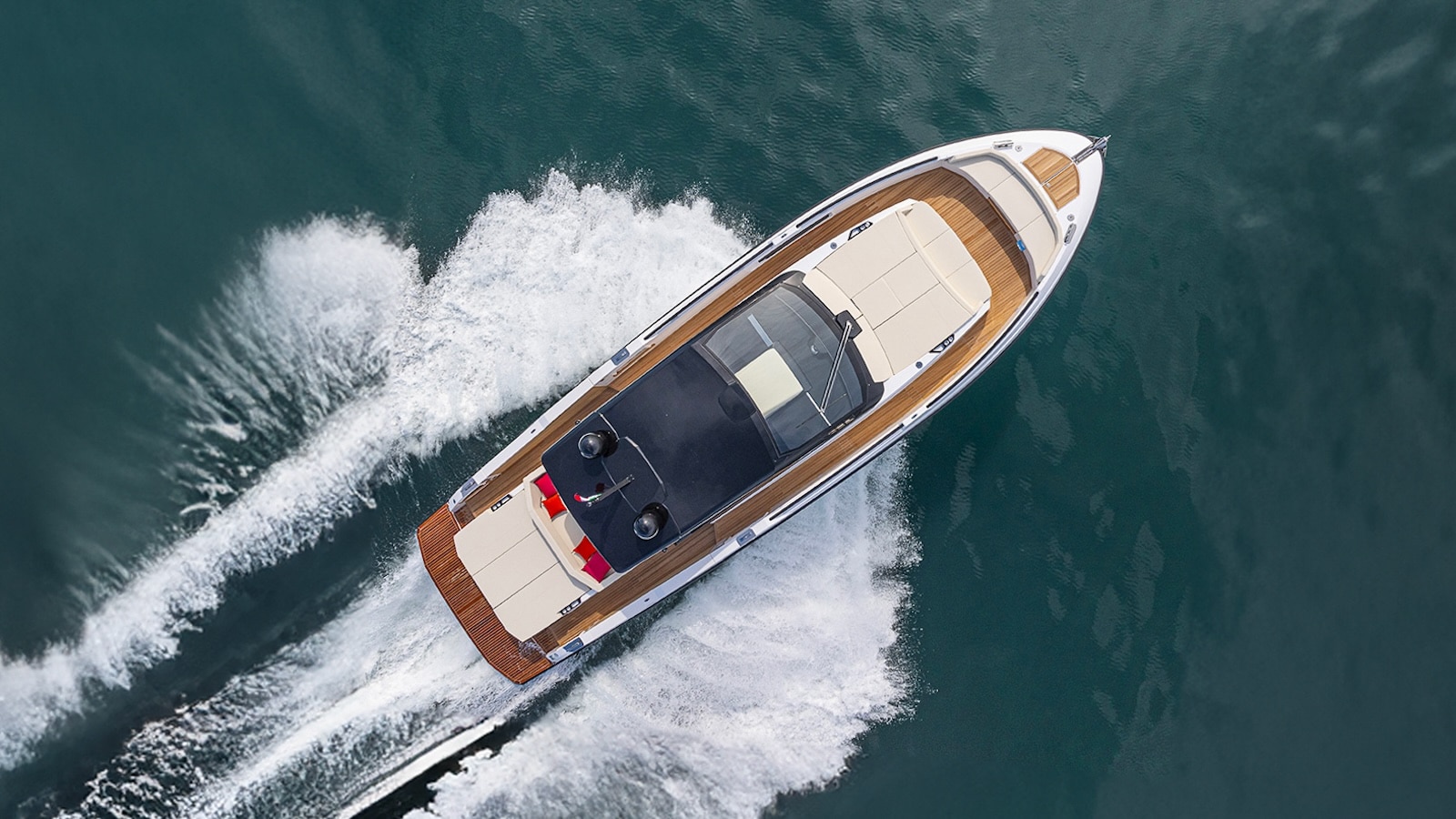
Rio Yachts: the new Le Mans 45 and 50 in world premiere at Cannes and Genoa

© 2021 – THE INTERNATIONAL YACHTING MEDIA Designed by BLive Communication
ABOUT YACHTINGNEWS.COM
Yachting News is an interactive multimedia magazine dedicated to the world of boating.
The International Yachting Media is the worlds most widely read boating magazines network. Whit its portal It broadcast its original contents in five languages and in more than 200 countries developing 950,000 views a week. Our web portals are the main source of information for yacht and boat owners, the place where they can find anything about their boating passion.
THEINTERNATIONALYACHTINGMEDIA.COM | SUPERYACHTS.NEWS | YACHT DIGEST
VIRTUAL BOAT SHOW | TUTTTOBARCHE | TOUSLESBATEAUX | TODOSLOSBARCOS
BOATING NEWS FREE APP

To provide the best experiences, we and our partners use technologies like cookies to store and/or access device information. Consenting to these technologies will allow us and our partners to process personal data such as browsing behavior or unique IDs on this site and show (non-) personalized ads. Not consenting or withdrawing consent, may adversely affect certain features and functions.
Click below to consent to the above or make granular choices. Your choices will be applied to this site only. You can change your settings at any time, including withdrawing your consent, by using the toggles on the Cookie Policy, or by clicking on the manage consent button at the bottom of the screen.
Subscribe For Latest Updates
Sign up to receive the best of Yachting News, sea trials, boat review and world premieres .
The only ADVERTISING FREE newsletter
A Complete Guide to Yacht Types and Sizes
- by yachtman
- August 28, 2023 June 22, 2024

Yachts, symbols of luxury and leisure, provide a stunning escape. From motor yachts to sailing yachts, the world of yachting is both diverse and captivating. Journey with us as we explore the different types and sizes of yachts, uncovering their secrets.
Climb onboard a superyacht , the queen of the seas. These floating palaces boast remarkable dimensions, with amenities such as swimming pools, helipads, and even submarines. Ideal for those seeking indulgence, superyachts are the epitome of yachting excellence.
For a more intimate experience, try a luxury motor yacht . With powerful engines, they let you visit multiple destinations quickly. Enjoy the lap of luxury as you cruise across the sea, appreciating every moment on board these vessels.
Sailing lovers will appreciate classic sailing yachts . Watch their silhouettes gracefully cut through the waves, powered by wind. Feel the passion for sailing, and the freedom, on an adventure akin to ancient seafarers. Uncover your inner explorer while savoring unparalleled serenity.
Catamarans are ideal for sailing with precision and finesse. With twin hulls offering stability and space, catamarans offer great comfort. Enjoy vibrant sunsets to tranquil anchorages, and bliss on water, with these versatile vessels.
For those keen on exploration, expedition yachts are perfect. Built tough and with advanced tech, they are designed for explorations to remote areas. Discover untouched landscapes, encounter wildlife, and make memories in the far-flung corners of the world.
Types of Yachts
Sailboats to mega-yachts – there’s a large choice of yachts. Let’s delve into the types and sizes that meet different needs.
Take a gander at the table below for an overview of yachts:
| Type | Size Range |
|---|---|
| Sailing Yacht | 20-100+ feet |
| Motor Yacht | 35-200+ feet |
| Catamaran | 30-80+ feet |
| Trawler Yacht | 40-100+ feet |
| Expedition Yacht | 70-400+ feet |
| Flybridge Yacht | 50-150+ feet |
| Sports Fisher Yacht | 30-70+ feet |
A guide to yacht anchor types and sizes is vital for understanding the different types and sizes available in the yacht industry. For more information, check out a guide to yacht tenders .
Sailing yachts are graceful and use wind power. Motor yachts are speedy and powered by engines.
Catamarans stand out with their steadiness and roominess – great for a leisurely cruise. Trawler yachts are great for long-distance trips because they’re fuel-efficient and have comfy living areas.
Adventurous souls should check out expedition yachts . Flybridge yachts have an extra deck level for entertainment and relaxation.
Sports fisher yachts are designed for fishing, with special gear and amenities.
Don’t miss out on your dream yacht – find the perfect one and go on amazing sea experiences. Start your journey now!
Sizes of Yachts
Yachts come in plenty of sizes, each with its own unique features and capabilities. To discover the perfect yacht for your needs, let us explore the sizes of yachts via a table showcasing their specifications.
Here’s what the table looks like:
| Size | Length | Capacity | Features |
| Tenders | Up to 30 ft | Up to 10 guests | Short trips and transportation to shore |
| Day Boats | 30-60 ft | Up to 12 guests | Day trips, water sports, and entertaining |
| Cruisers | 60-130 ft | Accommodates 8 Guests | Long journeys and luxury living |
| Superyachts | Over 130 ft | Large groups of guests | Swimming pools, helipads, and decks |
Moreover, take into account that certain yachts have stability systems, others prioritize speed, and some are customized. I once met a yacht owner who wanted a retractable roof! With the help of creative builders, his dream was fulfilled and he got to enjoy a unique experience on the open seas.
Factors to Consider in Choosing the Right Yacht
Making the right yacht choice involves many key points to think about. These include size, type, budget, use and preferences, like amenities . To decide wisely, assess each factor and see how important they are. Here’s a table of the main considerations when choosing a yacht:
| Factors | Description |
|---|---|
| Size | Think about how many guests you’ll have and if you want a larger or smaller yacht. |
| Type | Pick between motor, sail, catamaran or mega yachts based on your cruise plans and activities. |
| Budget | Establish a realistic budget that covers purchase costs, upkeep, crew wages, insurance fees and mooring. |
| Intended Use | Decide if you’ll mostly cruise or if you have special activities in mind like fishing or water sports. |
| Amenities and Features | Figure out what features and amenities are essential for your comfort onboard, such as cabins, entertainment systems, water toys or a jacuzzi. |
In addition, there are unique details you should consider, like if you plan to charter your yacht when not in use, go for a popular model. If privacy is important, choose a yacht with separate crew quarters. So, here are some tips for making the right choice:
- Get expert advice from experienced yacht brokers or naval architects.
- Choose respected brands that hold their value in case you resell.
- Visit boat shows and yacht exhibitions to explore different models and talk to professionals.
By taking all factors into account and following these suggestions, you can find the perfect yacht that fits your needs. Whether for leisure or adventure, the right yacht will give you amazing memories on the sea.
So many options! In this guide, we explore yacht types and sizes, helping you find the perfect vessel. From sailing yachts to motor yachts , each one offers a unique experience. Plus, you can customize your yacht for a truly special journey.
Let me tell you about James . He dreamed of a yacht that matched his adventurous spirit. So, he found a builder who specialized in customization. The result was amazing – a sleek motor yacht with state-of-the-art diving gear, space for fishing equipment, and luxurious comforts. On his customized vessel, James cruised beautiful coastlines and made memories that will last forever.
When you search for your yacht, remember that customization is key. You can have a tranquil sailing experience or a thrilling adventure. Dive into the ocean of possibilities – your imagination is the only limit.
Frequently Asked Questions
FAQ 1: What are the different types of yachts?
There are various types of yachts, including motor yachts, sailing yachts, catamarans, trimarans, superyachts, and expedition yachts. Each type offers unique features and advantages.
FAQ 2: What is the difference between a motor yacht and a sailing yacht?
A motor yacht, as the name suggests, is powered by an engine and offers more speed and convenience. On the other hand, a sailing yacht relies on wind power and provides a traditional sailing experience with a slower pace.
FAQ 3: What is a superyacht?
A superyacht is a luxury yacht with high-end amenities and extravagant features. These yachts often offer spacious cabins, multiple decks, swimming pools, helipads, and other luxurious facilities.
FAQ 4: What is the average size of a yacht?
Yachts can vary greatly in size. The average size of a yacht ranges from 30 to 60 feet. However, larger yachts, known as superyachts, can measure over 100 feet in length.
FAQ 5: What is the advantage of a catamaran or trimaran?
Catamarans and trimarans provide more stability due to their dual or triple hull design. They offer spacious interiors, increased deck space, and enhanced fuel efficiency compared to traditional monohull yachts.
FAQ 6: What is an expedition yacht?
An expedition yacht is designed for long-range cruising and exploring remote destinations. These yachts feature robust construction, advanced navigation systems, and ample storage for supplies and equipment.
Leave a Reply Cancel reply
Your email address will not be published. Required fields are marked *
Save my name, email, and website in this browser for the next time I comment.
- Pontoon Boats
- Personal Watercraft
- nauticalknowhow
- Nautical Knots
- Tools and Calculators
What is a Yacht?
A yacht does not have to meet any specific requirements to be considered a yacht. For our purposes a yacht is any recreational boat of around 30 feet or more that includes at least one cabin and is used for cruising or racing. This definition is not a hard and fast rule to go by as there is no settled definition for the word at all or what specifically makes a boat into a yacht.
Because a yacht is not a specific type of easily identified vessel like a pontoon boat or a fishing boat, we’ll cover the features of what makes a yacht worthy of the name so make it easier for you to identify one in the wild.
Defining What a Yacht Is
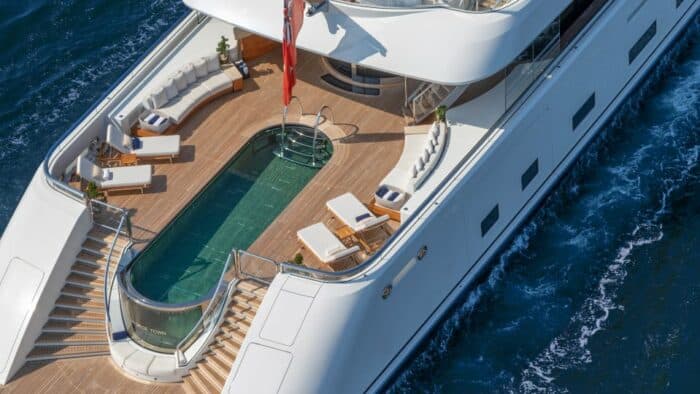
The difficulty in defining the term “yacht” is that, unlike the specific vessels mentioned above, a yacht is more of a description than a type. Yachts can be sailboats or motorboats, center console boats, house boats or any other kind of vessel that meets the generally accepted size and feature expectations of a yacht.
The definition I gave above includes a few key points:
- A yacht is a recreational boat
- A yacht is 30 feet long or more
- A yacht has at least one cabin
- A yacht is used for cruising or racing
This description allows you to weed out some things such as:
- Boats under 30 feet which most recreational boats are
- Specific purpose boats like commercial fishing vessels, barges, tugboats
- Most pontoon boats, speed boats for racing, jon boats and recreational fishing boats
Reaching a Definition
Usually when people think of yachts they’re thinking of a medium to large vessel that is well appointed and higher end with a lot of luxury features. The word evokes a sense of value and expense. We consider a yacht to be an expensive boat.
Yachts can be very similar to a cabin cruiser or day sailing boats , but the difference seems to be in size and what may be included above and beyond a “normal” boat. For these reasons, “yacht” as a term is sometimes hard to define and definitions will not be consistent from one source to another.
Motor Yacht Vs. Sailing Yacht
The initial definition of yacht that we provided doesn’t specify if a yacht is a boat that requires wind power to move or an engine. But the fact is that a yacht can be a sailing vessel or a powered vessel and either one can still qualify as a yacht.
Motor Yacht
The power source for a motor yacht is an engine. Some yachts are hybrid vessels which can run under sail but also have a backup engine in case of emergencies or if the wind is not reliable. These are sometimes called motorsailers.
Motor yachts are considered leisure vessels more often than sailing yachts due to how they work. A motor yacht takes less skill to operate than a sailing yacht.
Sailing Yacht
Sailing yachts run strictly on wind power. Most larger sail boats with cabins could be considered yachts. Many boaters still consider a sailing yacht a boat for people who are more adventurous and a little wild as they represent that idea of cutting loose at sea. A sailing yacht is harder to operate than a motor yacht and requires more skill.
A motor yacht is going to get you where you want to go faster than a sailing yacht. That’s not to say these aren’t fast sailing vessels as modern yachts can reach great speeds, but they are still at the mercy of the wind. For that reason you’ll often see far more motor yachts around than sailing yachts as they tend to be more convenient for most boaters.
Motor yachts have no concrete average speed thanks to numerous factors that go into what makes a yacht. The largest yacht in the world is nearly 600 feet long. Obviously a boat of this size has many variables that will affect its speed compared to a 60 foot yacht. That said, yachts of any size tend to have cruising speeds that range from 20 mph to 30 mph.
Because a sailing yacht is powered by wind only it will be slower, on average, than a motor yacht. Sailing yachts often reach speeds of just 5 mph to around 10 mph. The size and construction of the vessel, its weight, and the skill of the captain can all affect these numbers.
A motor yacht has to make space for an engine room, which can get quite huge especially on large yachts. Space is also needed for fuel tanks. On some mega yachts they have fuel tanks that can hold over a million liters of fuel, which is absolutely staggering and requires a large portion of the vessel.
Motor yachts are more likely to devote space to luxury amenities like hot tubs or even swimming pools. The largest motor yachts have multiple luxury cabins, helipads, tenders, gyms and more. Some motor yachts can have up to 8 decks. You can expect a motor yacht at 150 feet to have around 50% or more space available than the exact same length in a sailing yacht.
Sailing yachts can be designed smaller than motor yachts because they don’t need engine or fuel space. So a smaller sailing yacht can hold as many passengers as a larger motor yacht without sacrificing comfort or luxury. A sailing yacht is going to have a smaller and probably narrower structure than a motor yacht.
Sailing yachts often offer comfortable cabins but usually have few hotel-like luxuries on board. A sailing yacht needs a lower profile to function properly. They will have fewer decks as well.
Motor yachts lend themselves more towards really having fun at sea. These are true recreational vessels. This is owing to the fact motor yachts are more likely to have tender garages and include jet skis and other equipment for getting out and having fun.
Motor yachts also tend to be the ones that are more outfitted like small resorts. You can find dance floors, bars, swimming pools, jacuzzi tubs, gyms and more on some big luxury yachts. At some point they really start to look like small cruise ships. With the extra decks and of course because they don’t have masts in the way, there’s a lot more space for this kind of thing.
Modern sailing yachts have been designed with more luxury features than older models and it’s not unheard of to find a jacuzzi on a sailing yacht or even a cinema on some, but it’s still a rarity when compared to motor yachts.
Sailing yachts can be used for some more limited type fun at sea – lots of snorkeling, swimming, fishing and so on, just not to the extreme that a motor yacht will do. A lot of the appeal of a sailing yacht is the fact that it’s for sailing, so the act of sailing itself is the draw. Usually people who own and operate sailing yachts want to engage in the activity of sailing, rather than the extra things you might enjoy on a motor yacht.
Cost of Motor Yachts vs Sailing Yachts
Motor yachts are more expensive than sailing yachts. The initial cost can vary widely but it’s the long term costs that nail you. Fuel and maintenance costs over time for a motor yacht will always keep raising the price. The largest motor yachts may cost millions of dollars to buy outright and also have yearly operating costs in the hundreds of thousands or even millions if they are fully crewed. The highest priced yacht in the world has a $1.5 billion price tag.
A sailing yacht continues to coast along at a much lower cost in terms of necessary maintenance. After all, you never need to refuel your sailing yacht. Some smaller yachts may cost under $30,000.
Yacht Classifications
Yachts are often classified by size. As we defined early, any vessel over 30 feet can potentially be a yacht. But if you are talking about a vessel that is over 400 feet in length, it’s not an accurate picture to use the same term.
We often classify yachts using common size or metric prefixes. You may have heard the terms “superyacht” and “megayacht.” These are ways of attempting to differentiate between the sizes of yachts because some of these vessels can get massive. The world’s largest yacht, the Azzam, is about 600 feet long.
Large Yacht
According to the Commercial Yacht Code, a large yacht is any yacht that has reached 79 feet or more. At this size the boat needs to have an actual crew to keep it running. Anything under 79 feet would just be a standard yacht.
Super Yacht
To qualify as a super yacht, a vessel has to be at least 131 feet in length. Obviously this size means it needs a fairly extensive crew and, if it’s not a commercial vessel, it’s probably owned by someone extremely wealthy in order to maintain it.
The term mega yacht is a bit sketchy which is no surprise given how there’s only a loose definition for the word “yacht” in the first place. Mega yacht and superyacht are often used synonymously. However, for some people, the term mega yacht can only be applied when the vessel reaches at least 200 feet. This doesn’t seem to be a definite rule though so if you hear the term it’s still best to look at the specs of the boat to see what’s being referred to.
You hear this term a lot less frequently but it’s been tossed around to account for those yachts that would even leave a mega yacht in the dust. After all, if a super yacht is 131 feet and a mega yacht is 200 feet then a yacht like Azzam, at 600 feet, should probably be known by a different term since it’s so much bigger.
Giga yacht is sometimes used to represent these largest yachts. But again, this is an informal label for such a large boat and there are no hard and fast rules about what size a boat has to be in order to be called a giga yacht. In general it just means the biggest of the big.
Racing Yachts
If the point of the yacht is specifically to be involved in racing, then it will likely be stripped down of many of the more luxurious but unnecessary amenities seen in recreational and cruising yachts. Usually a racing yacht has less space for relaxing or sleeping, for instance, but there are definitely yachts being built that offer a lot of nice features while still being designed to race.
The Bottom Line
There are no distinct rules for the size of a yacht or what it can even do. A yacht can operate under motor power or under sailing and you can use it to race, to just have fun, or for cruising. They can range in size from just 30 feet all the way up to the massive 600 foot Azzam.
A yacht is a vessel that is fairly luxurious and used recreationally for a variety of purposes. A luxury yacht may be chartered for business or events and come with a full crew while smaller motor powered yachts and sailing yachts tend to be used for pleasure cruising.
My grandfather first took me fishing when I was too young to actually hold up a rod on my own. As an avid camper, hiker, and nature enthusiast I'm always looking for a new adventure.
Categories : Yachts
Leave a Reply Cancel reply
Your email address will not be published. Required fields are marked *
Save my name, email, and website in this browser for the next time I comment.
More in Yachts
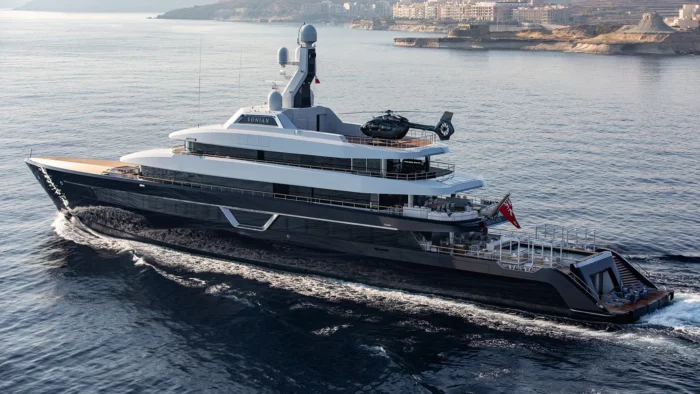
Lonian Yacht: An Insider's Guide
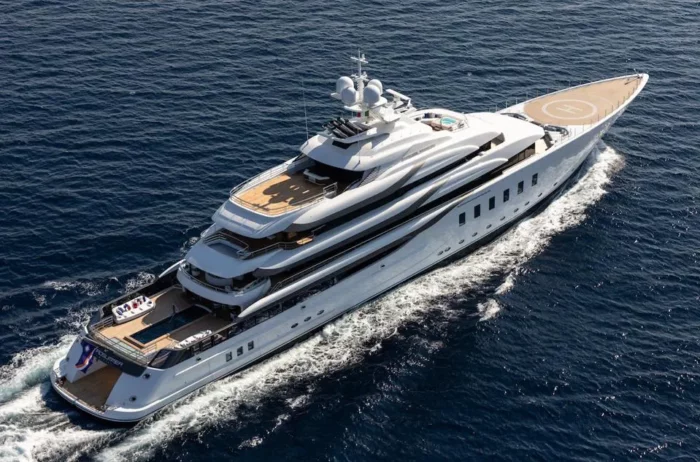
A Closer Look at the Madsummer Yacht
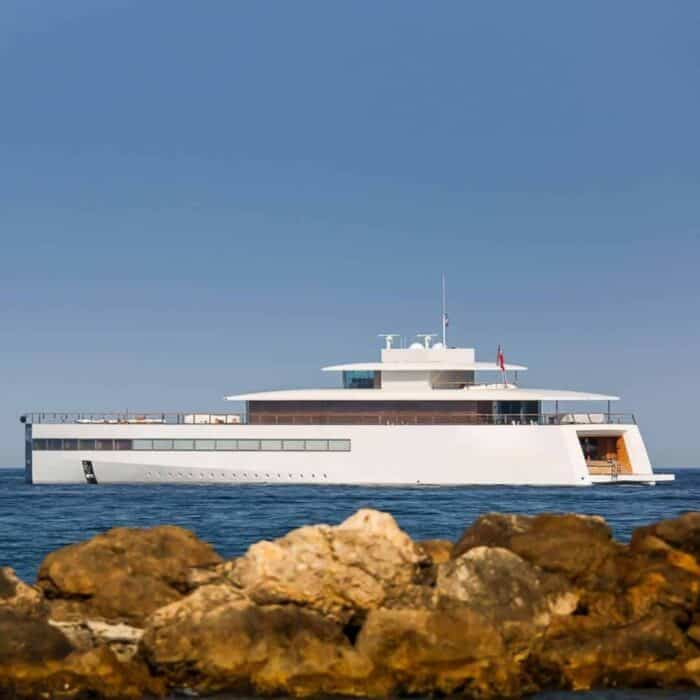
Your Insider’s Look at Steve Jobs’ Yacht Venus
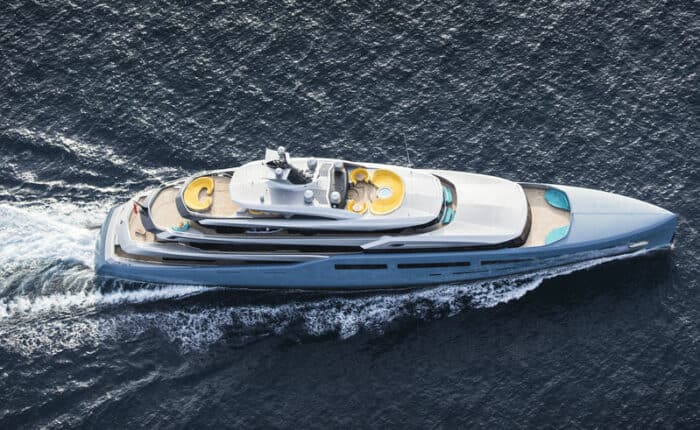
Your Insider’s Guide to the Aviva Yacht

The People’s Poncho Review and Ratings

Oru Lake Kayak Review

What Is A Gunwale?

131 of the Best Hawaiian Boat Names

167 Patriotic Boat Names
About boatsafe.
Established in 1998, BoatSafe is your independent guide into the world of boating, fishing, and watersports. We provide expert insights and detailed guides to help you find products tailored to your needs and budget.
Contact Boatsafe
- Address: 4021 West Walnut Street. Rogers, AR 72756
- Phone: (479)339-4795
- Email: [email protected]
Site Navigation
- How We Test
- Corrections Policy
- Privacy Policy
- Terms & Conditions
- Editorial Policy
- Affiliate Disclosure
Our Reviews

All content is © Copyright 2024. All rights reserved.

IMAGES
VIDEO
COMMENTS
The term "Yacht Certified" refers to a quality control process governed by the NMMA, an organization that ensures that yachts and boats are constructed to industry standards. As many as 90% of boats currently on the water in the U.S. carry an NMMA certification placard. ... To meet the definition of a yacht, the boat must be 26 feet or ...
The answer is, it depends. When I started writing about boats over two decades ago, the Mason-Dixon line stood firmly at 80 feet. That was the length overall where we stopped calling a model a "boat" and switched to the term "yacht.". Editors, at the time, reasoned that once a boat owner hit 80 feet length overall, hiring a crew was no ...
Yachts are also classified according to what sort of water and wind conditions they can withstand. Let's take a quick look at these classifications below: "Class A" Yachts are those that can handle winds of up to 45-50 miles-per-hour and approximately 13-foot waves in open seas. These types of offshore yachts are built to be self ...
Yacht certification is a process that evaluates a yacht's safety, performance, and overall quality to ensure it meets necessary requirements for safe operation in various waters. Understanding the details of yacht certification is important for all yacht owners to ensure the safety of their vessel and those on board.
Boats are usually associated with serving a purpose such as fishing or transportation. If a boat is a leisure vessel, it would usually be much smaller than a yacht. Leisure boats are often found on rivers, lakes, canals, or shallow coastal waters. These are something that most people get to enjoy from time to time and don't exactly come with ...
A hundred years ago a yacht was considered seaworthy . if it could stand up to a full gale whilst continuing to make headway under sail while still keeping its crew safe. Today, yachts are designed and built using entirely different construction parameters, with far more emphasis on speed, ease of handling, openness and comfortable living.
How the Yacht-Certified Placard Benefits You. "Yacht Certification" is a manufacturing quality standard implemented by the NMMA under a vetting process established by the American Boats & Yacht Council. The advantage of this for boat buyers - including Cobalt owners, of course, since every yacht-certified Cobalt model goes through NMMA ...
But, yachts often start in the six-figure range and can reach millions of dollars depending on the yacht's size, age, and build quality. Maintenance and Repairs. Yachts are frequently more expensive to maintain than sailboats. Meaning that boat engines require a great deal of upkeep, and the expense of fuel can be prohibitive for many ...
A 45-foot cruising yacht in 2010 The superyacht Azzam, the longest private yacht, as of 2018. [1]A yacht (/ j ɒ t /) is a sail- or motor-propelled watercraft made for pleasure, cruising, or racing. [2] [3] [4] There is no standard definition, though the term generally applies to vessels with a cabin intended for overnight use.To be termed a yacht, as opposed to a boat, such a pleasure vessel ...
These yachts are constructed to be self sufficient in hostile seas. A Class B yacht ( boat ) is a vessel built to navigate on the offshore waters (200 miles and less) and can substain UP TO force 8 and waves UP TO 4 meters. A Class C boat is a vessel built to navigate inshore such as lakes, rivers, bays and close to the shore and can sustain UP ...
Definition of a Yacht. Understanding what defines a yacht involves more than just its size or luxurious appeal. A yacht is a vessel used primarily for leisure, cruising, or racing. Typically, yachts are larger than other recreational boats, often exceeding 33 feet (10 meters) in length, which is a key factor when a boat is considered a yacht ...
A yacht is a water vessel used for recreation, racing, or cruising, powered by sail or motor. A yacht can be a medium-sized water vessel or a small ship used for private and official purposes. However, there is really no standard definition because you can use this term for any watercraft with cabins, accommodations, and amenities for overnight ...
Yacht Definition & Origin. The word yacht comes from the Dutch word "jacht", which means to hunt, and refers to the quick and lightweight sailboats the Dutch navy used to pursue pirates and other enemies in shallow waters. Today, the word takes on a very different meaning. While there is no strict definition of the word today, a yacht is ...
Yacht owners guide to Classification Societies. 21 January 2015 • Written by Benjamin Maltby. Alysia was built specifically for charter and complies to SOLAS. She can carry up to 36 passengers and is over 500GT. Classification societies (also known as 'class' societies) make an important contribution to maritime safety.
Quality family time. Spending time on a yacht can provide quality family time and create unforgettable memories. It's a great way to bond and connect with loved ones while experiencing new and exciting destinations. There are many beautiful places you can visit on a yacht, depending on your preferences and interests. ...
Yacht definitions: A brief history. Whilst boating for fun dates back to Ancient Egypt and possibly even further than that, the word yacht comes from the Dutch 'jachtschip', which means hunting ship. Jachts were originally a class of sailboat used in the 16th century to hunt down enemies of the Dutch Republic.
Generally, a yacht is defined by its length, luxurious amenities, and purpose for leisure rather than work. While there is no universal definition, a boat is typically considered a yacht when it exceeds 33 feet (10 meters) in length. The length is a crucial factor in determining what size boat is considered a yacht.
The quality in boat building is a multi-faceted endeavor involving meticulous planning, skilled craftsmanship, and rigorous testing. By adhering to established protocols and standards, manufacturers can deliver boats that are not just impressive to look at but also safe, durable, and high-performing. Quality is, indeed, the true north that ...
Large yacht. A large yacht is a pleasure vessel with a load line length equal to or over 24m. Almost all the flag administrations have adopted safety codes dedicated to large yachts and this is, therefore, the only definition having a universal meaning in the international regulatory framework of yachts.. Commercial yacht
Yachts can range in size depending on the type of boat and its intended use, but all will typically include luxury features and amenities for a comfortable and enjoyable experience. The Definition of Yacht. Yacht is a term often used to describe a variety of large and luxurious recreational boats, typically used for personal pleasure or sport.
As mentioned above, a yacht may be equipped with sailing, motor or mixed propulsion. It can have more than one hull, and if it exceeds 25 meters it also deserves the definition of superyacht. When a yacht is over 50 meters it is called a megayacht and, more and more frequently, when it exceeds 100 meters it becomes a gigayacht.
A guide to yacht anchor types and sizes is vital for understanding the different types and sizes available in the yacht industry. For more information, check out a guide to yacht tenders.. Sailing yachts are graceful and use wind power.Motor yachts are speedy and powered by engines.. Catamarans stand out with their steadiness and roominess - great for a leisurely cruise.
Yachts can be sailboats or motorboats, center console boats, house boats or any other kind of vessel that meets the generally accepted size and feature expectations of a yacht. The definition I gave above includes a few key points: A yacht is a recreational boat. A yacht is 30 feet long or more. A yacht has at least one cabin.